Special Report
States Where Alzheimer's Is Soaring

Published:
Last Updated:

The number of people with Alzheimer’s disease, a degenerative brain disease and the most common form of dementia, will rise by at least 14% in all 50 states over the next eight years. However, the rate of increase will be higher in some states than others, according to a recent report from the Alzheimer’s Association, placing greater financial stress on health care programs and boosting the need for caregivers.
Alaska is projected to have the biggest increase in Alzheimer’s cases, from 7,100 in 2015 to 11,000 in 2017, or a 54.9% jump. Arizona, Nevada, Vermont, and Utah round out the top five with projected increases of at least 40% each. Iowa is expected to have the lowest increase, from 64,000 to 73,000, or 14.1%.
24/7 reviewed the Alzheimer’s Association “2017 Alzheimer’s Disease Facts and Figures” report to find for each state the projected percentage increase in the number of people with Alzheimer’s over the next eight years. States in the West and Southeast are expected to have the largest percentage increases in the number of people with Alzheimer’s between 2017 and 2025.
Click here to see the states where people will suffer the most from Alzheimer’s.
Click here to see our detailed findings and methodology.
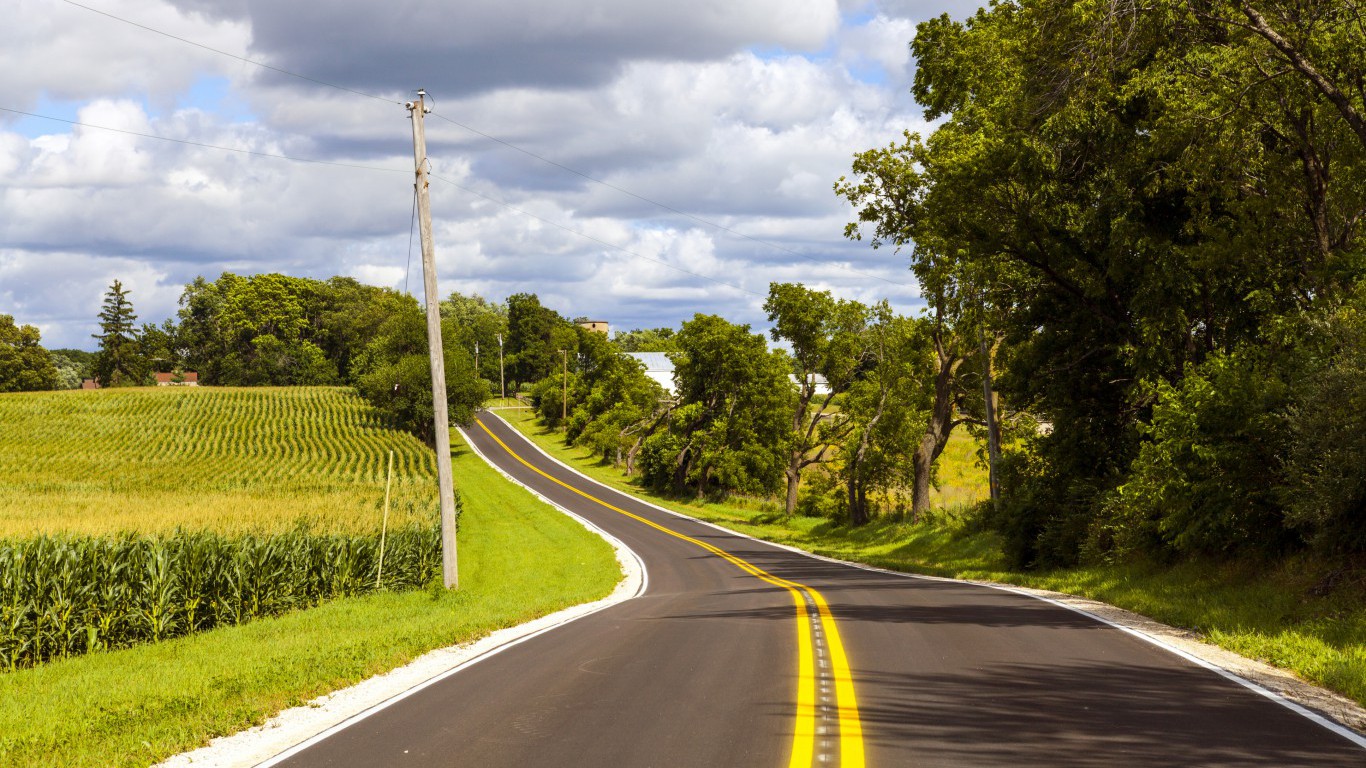
50. Iowa
> Increase in Alzheimer’s, 2017-2025: 14.1%
> Pct. of 65+ pop. with Alzheimer’s: 12.8% (7th highest)
> Population 65+: 16.0% (15th highest)
> Pct. of 65+ pop. in good health: 80.4% (4th highest)
> Avg. retirement income: $20,252 (4th lowest)
There will be a significant increase in Alzheimer’s cases in every state. The number of people living with Alzheimer’s disease in Iowa is projected to climb by 14.1% between 2017 and 2025, the smallest increase of all states. The projected growth of each state’s elderly population is one of the best predictors of how fast Alzheimer’s cases will increase. Nearly 13% of the Iowa’s elderly population has the disease. While this is the seventh highest percentage of all states, it is expected to grow by just 20.7%, one of the slowest growths. The Alzheimer’s death rate in Iowa of 42 for every 100,000 people is fifth highest nationwide.
[in-text-ad]

49. North Dakota
> Increase in Alzheimer’s, 2017-2025: 14.3%
> Pct. of 65+ pop. with Alzheimer’s: 13.0% (5th highest)
> Population 65+: 14.2% (11th lowest)
> Pct. of 65+ pop. in good health: 75.6% (21st lowest)
> Avg. retirement income: $22,776 (22nd lowest)
While the prevalence of Alzheimer’s in North Dakota will climb at a slower rate than in almost all states, a relatively large share of the state population dies from the disease. With nearly 50 deaths per 100,000 people, North Dakota has the second highest mortality rate for deaths associated with Alzheimer’s disease.

48. Rhode Island
> Increase in Alzheimer’s, 2017-2025: 17.4%
> Pct. of 65+ pop. with Alzheimer’s: 13.5% (the highest)
> Population 65+: 16.1% (13th highest)
> Pct. of 65+ pop. in good health: 78.1% (16th highest)
> Avg. retirement income: $25,966 (16th highest)
An estimated 13.5% of Rhode Island’s elderly population have Alzheimer’s, the highest share of all states. Alzheimer’s disease was the fifth leading cause of death in Rhode Island in 2014.
Living alone in old age can be a sign of social isolation, but also an indication of independence for many older Americans, as well as people with the disease. For individuals living with late-stage Alzheimer’s disease, living alone can be unsafe. About 31% of Rhode Island residents 65 and older live alone, the second highest share of any state.
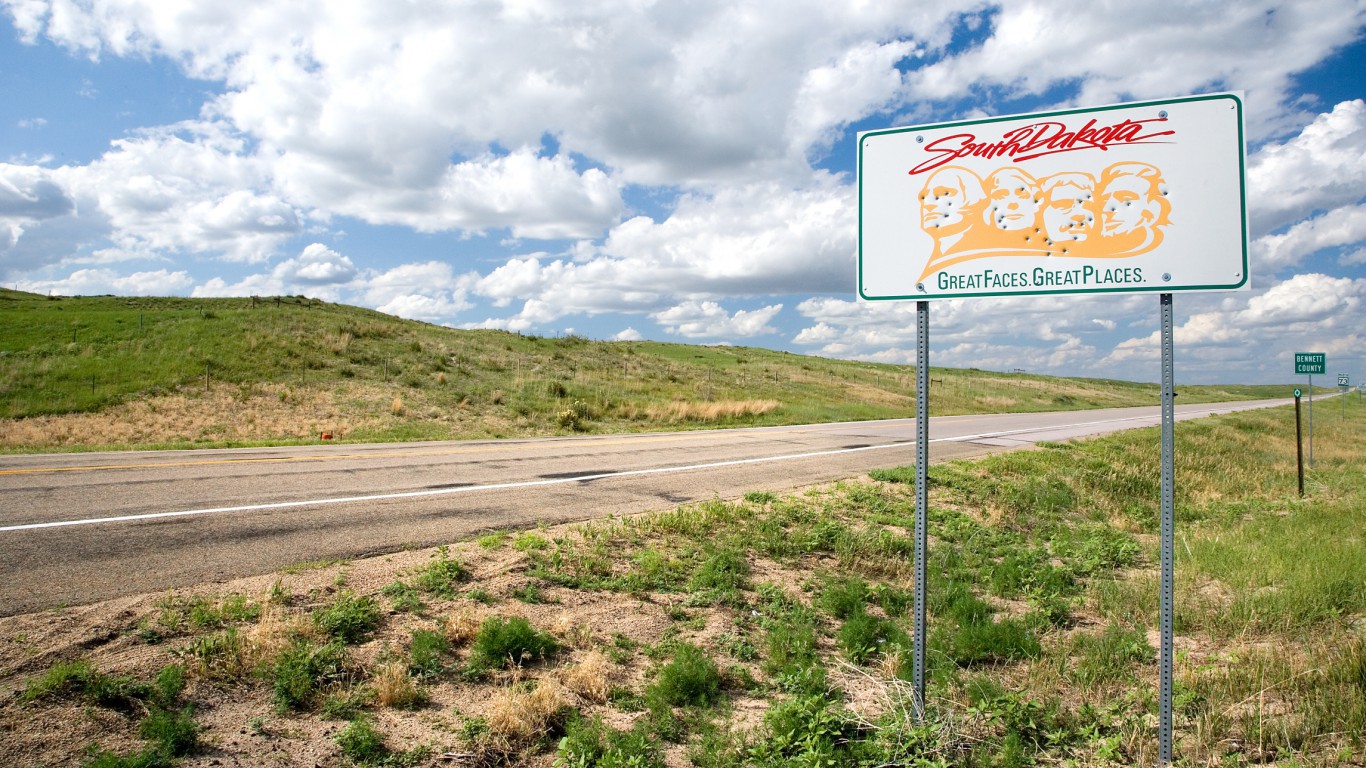
47. South Dakota
> Increase in Alzheimer’s, 2017-2025: 17.6%
> Pct. of 65+ pop. with Alzheimer’s: 12.6% (9th highest)
> Population 65+: 15.7% (21st highest)
> Pct. of 65+ pop. in good health: 77.0% (23rd highest)
> Avg. retirement income: $20,765 (5th lowest)
South Dakota had the highest mortality rate from Alzheimer’s disease of any state with 50.9 deaths per 100,000 state residents. The relatively high incidence of the disease among the state’s elderly population largely explains the high mortality rate. States with low projected increases in the incidence of Alzheimer’s disease almost always have low projected growths in the elderly population, but South Dakota is the exception. The state’s 65 and older population is projected to grow by nearly 27% by 2025, versus the national average growth of approximately 25%.
Regardless, like every other state, South Dakota will need more caregivers. Currently there are only 2.2 caregivers in the state for every Alzheimer’s patient, the fifth lowest ratio in the U.S.
[in-text-ad-2]

46. New York
> Increase in Alzheimer’s, 2017-2025: 17.9%
> Pct. of 65+ pop. with Alzheimer’s: 13.2% (4th highest)
> Population 65+: 15.0% (22nd lowest)
> Pct. of 65+ pop. in good health: 73.7% (14th lowest)
> Avg. retirement income: $26,249 (15th highest)
New York’s Medicaid costs for those 65 and older with Alzheimer’s are expected to be $4.6 billion in 2017, the most of any state. Despite a slower than average eight-year growth rate in the number of elderly people with the disease, the state’s Alzheimer’s-related Medicaid costs are expected to remain the highest in the nation also in 2025.
The Empire State has more than 1 million caregivers tending to those with Alzheimer’s disease, or about 2.6 for every Alzheimer’s patient.
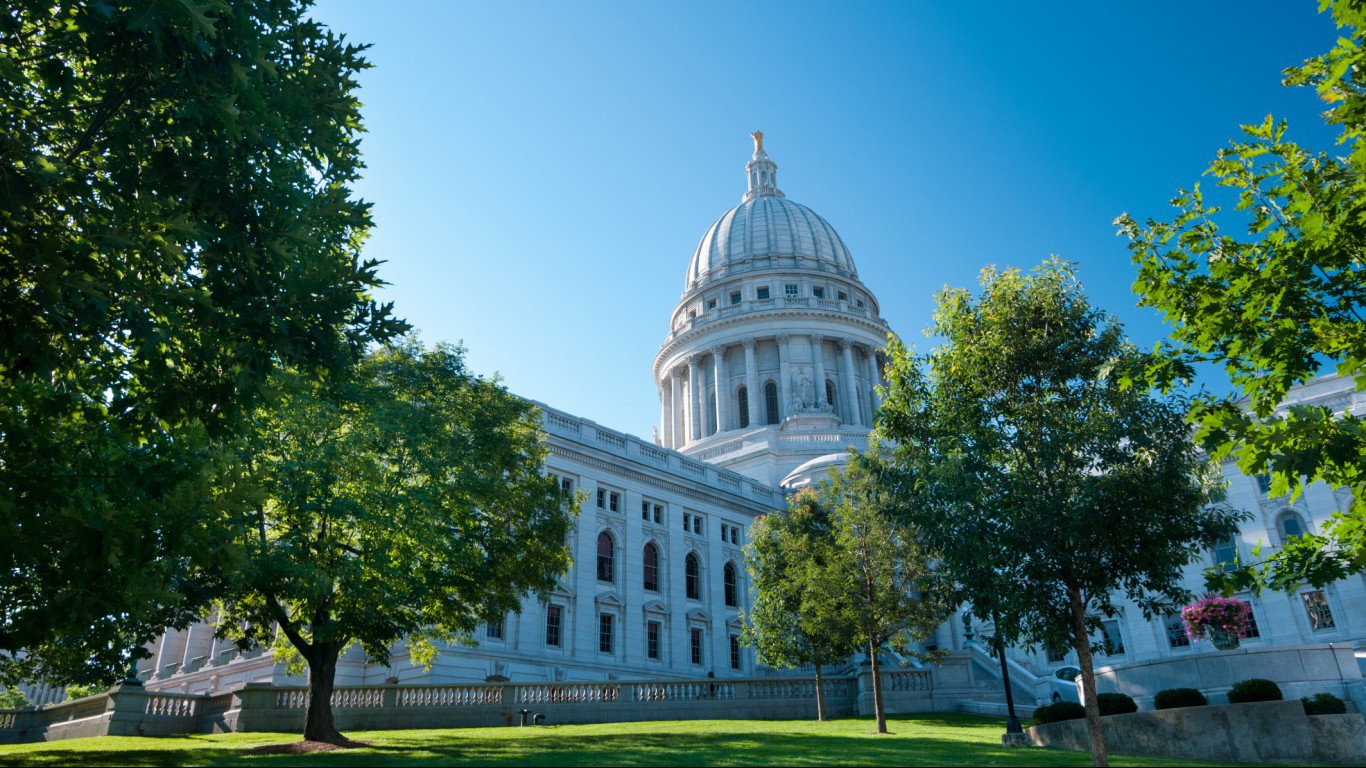
45. Wisconsin
> Increase in Alzheimer’s, 2017-2025: 18.2%
> Pct. of 65+ pop. with Alzheimer’s: 12.2% (11th highest)
> Population 65+: 15.6% (23rd highest)
> Pct. of 65+ pop. in good health: 78.3% (14th highest)
> Avg. retirement income: $21,149 (8th lowest)
In Wisconsin, 1,876 people died from Alzheimer’s disease in 2014, or 32.6 for every 100,000 people, a slightly higher than average mortality rate. States with more elderly adults tend to have more residents with Alzheimer’s Dementia, and states that currently have relatively more cases of the disease tend to have lower projected increases. Wisconsin fits this pattern as 12.2% of people 65 and older have Alzheimer’s, the 11th highest such percentage.
There are only 1.8 caregivers for every Alzheimer’s patient in Wisconsin, the lowest ratio of any state.
[in-text-ad]

44. Missouri
> Increase in Alzheimer’s, 2017-2025: 18.2%
> Pct. of 65+ pop. with Alzheimer’s: 11.6% (21st highest)
> Population 65+: 15.6% (22nd highest)
> Pct. of 65+ pop. in good health: 73.7% (14th lowest)
> Avg. retirement income: $21,480 (13th lowest)
In Missouri, Medicaid costs associated with caring for people with Alzheimer’s disease are predicted to rise 30.7% from 2017 to 2025, one of the lowest projected increases of all states. The number of elderly people with the disease will increase by 18.2% over the same period, the seventh slowest increase among states.
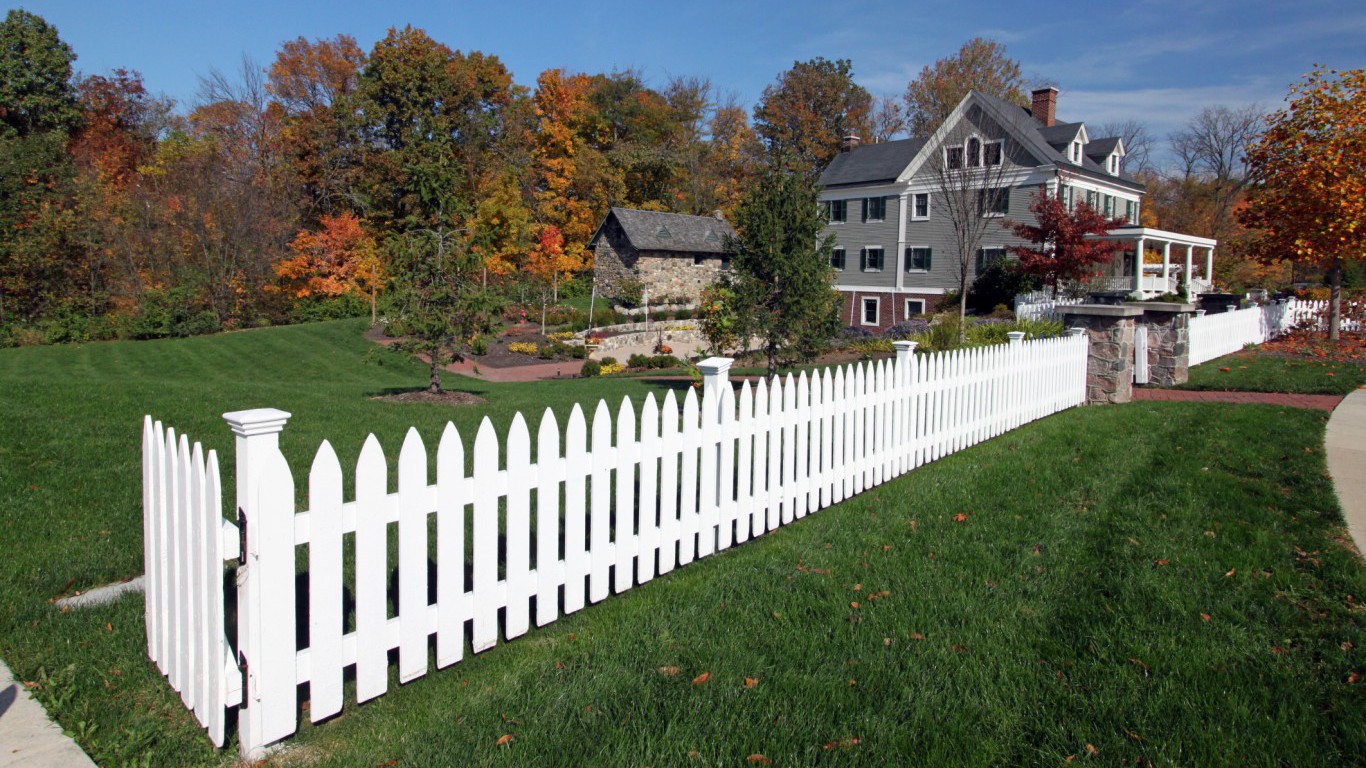
43. Indiana
> Increase in Alzheimer’s, 2017-2025: 18.2%
> Pct. of 65+ pop. with Alzheimer’s: 11.4% (23rd lowest)
> Population 65+: 14.6% (14th lowest)
> Pct. of 65+ pop. in good health: 73.9% (16th lowest)
> Avg. retirement income: $17,659 (2nd lowest)
The number of people living with Alzheimer’s disease in Indiana will rise by 18.2% to 130,000 from 2017 to 2025. Alzheimer’s-related Medicaid costs for state residents age 65 and older are projected to reach $913 million this year. In the next eight years, that figure is expected to increase by 30.9% — much lower than the national projected increase of 37.1% — to nearly $1.2 billion.
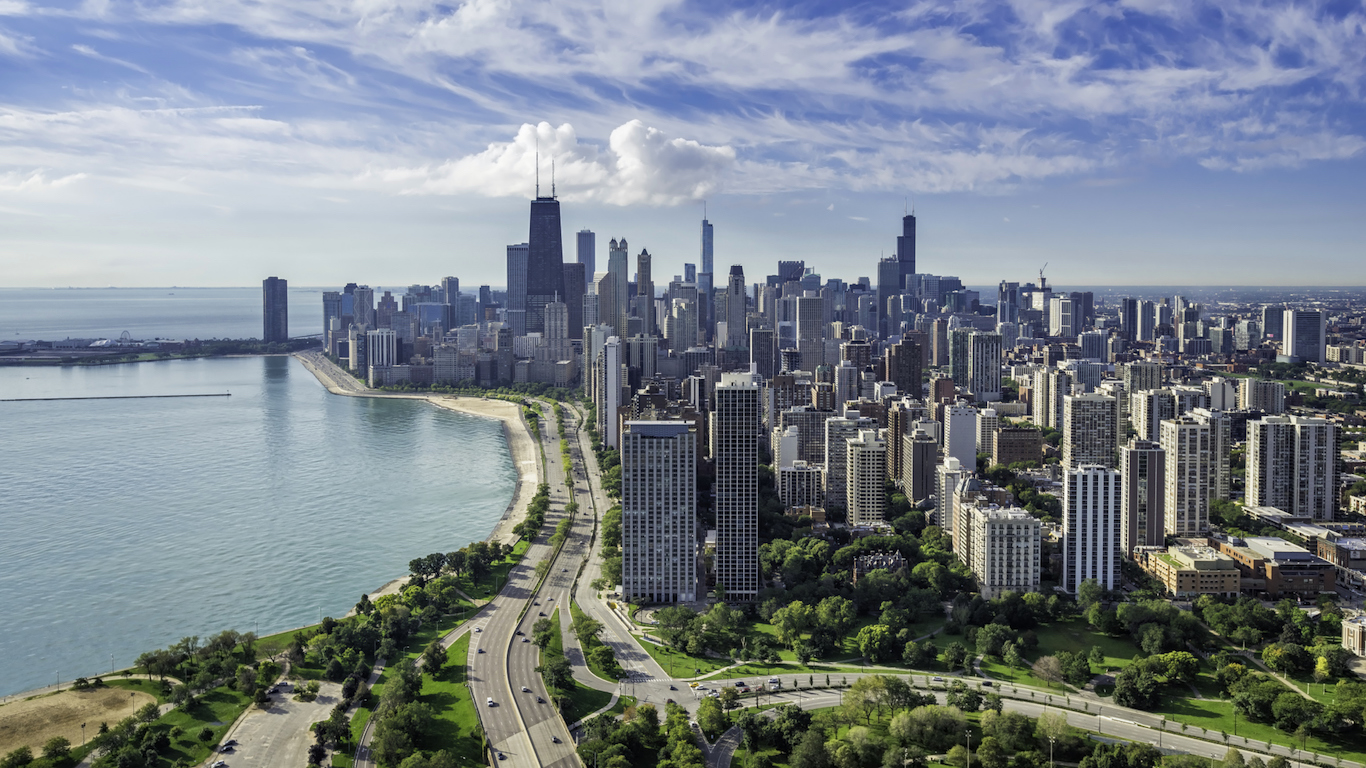
42. Illinois
> Increase in Alzheimer’s, 2017-2025: 18.2%
> Pct. of 65+ pop. with Alzheimer’s: 12.0% (14th highest)
> Population 65+: 14.2% (12th lowest)
> Pct. of 65+ pop. in good health: 71.8% (11th lowest)
> Avg. retirement income: $27,638 (8th highest)
In Illinois, Medicaid costs to care for those with Alzheimer’s disease are forecast to rise 36.4% from 2017 to 2025 — slightly less than average. Every state will need to invest more resources in caring for Alzheimer’s patients in coming years. While Illinois is no exception, the state started addressing the disease many years ago. Illinois’ legislative package known as the “Alzheimer’s Initiative,” which is designed to advance research and treatment, was approved already back in 1985.
[in-text-ad-2]

41. Pennsylvania
> Increase in Alzheimer’s, 2017-2025: 18.5%
> Pct. of 65+ pop. with Alzheimer’s: 12.4% (10th highest)
> Population 65+: 17.0% (6th highest)
> Pct. of 65+ pop. in good health: 75.7% (22nd lowest)
> Avg. retirement income: $21,263 (10th lowest)
The number of 65 and over people in Pennsylvania, who currently comprise 17% of the population, is expected to grow by less than 20% by 2025, nearly the slowest projected elderly population growth of all states.
Medicaid costs for caring for people with Alzheimer’s disease in Pennsylvania are estimated to be $3.23 billion in 2017. Alzheimer’s-related Medicaid spending is projected to increase by only 20.7% in the next eight years, the smallest projected spending growth of any state. Lower Medicaid costs for elderly populations are generally expected in states with lower projected increases in Alzheimer’s cases.
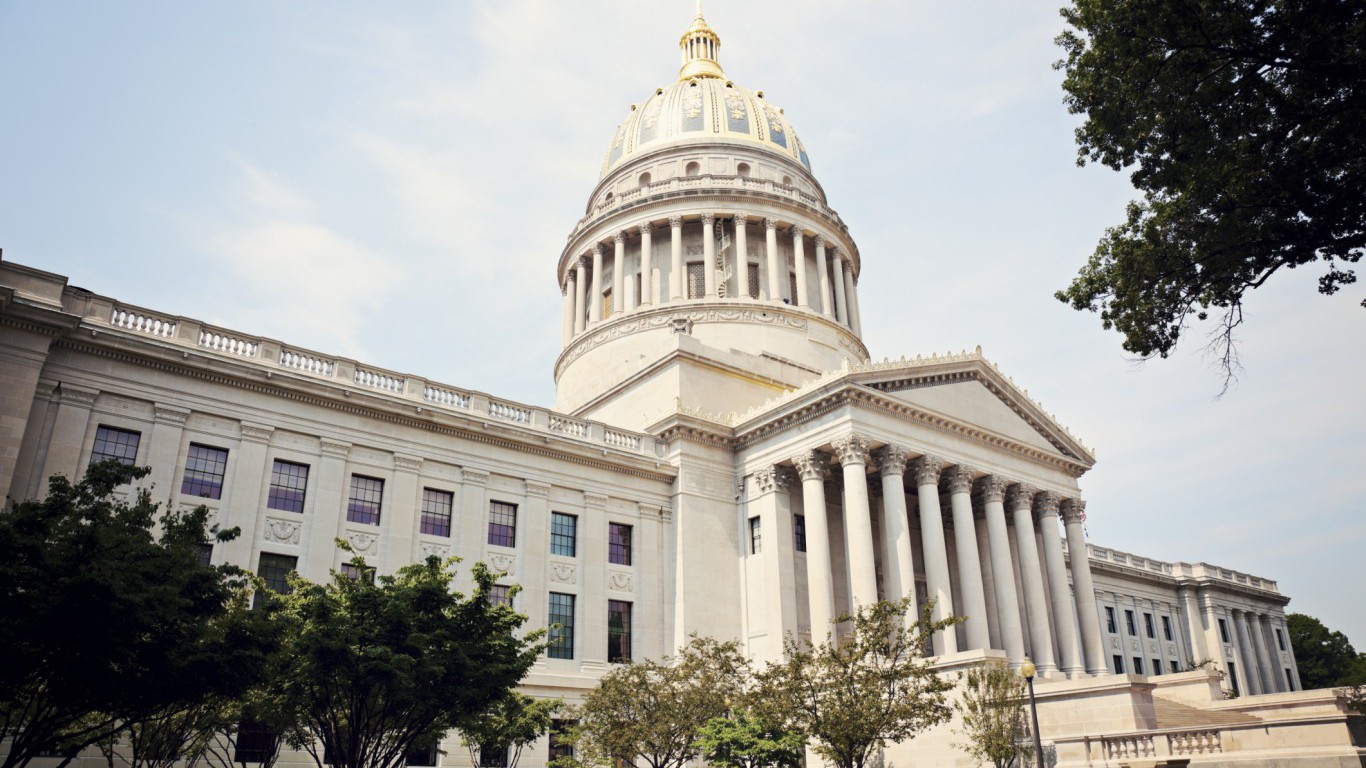
40. West Virginia
> Increase in Alzheimer’s, 2017-2025: 18.9%
> Pct. of 65+ pop. with Alzheimer’s: 11.0% (17th lowest)
> Population 65+: 18.2% (3rd highest)
> Pct. of 65+ pop. in good health: 65.6% (3rd lowest)
> Avg. retirement income: $17,113 (the lowest)
In West Virginia, 620 people died from Alzheimer’s disease in 2014. At approximately 33.5 deaths per 100,000 state residents, mortality from the disease is one of the highest compared with other states.
Alzheimer’s disproportionately affects elderly and retired populations, and treatment can be very expensive. West Virginia has the third largest elderly population, at 18.2% of residents, and the lowest average retirement income of all states, at $17,113.
[in-text-ad]
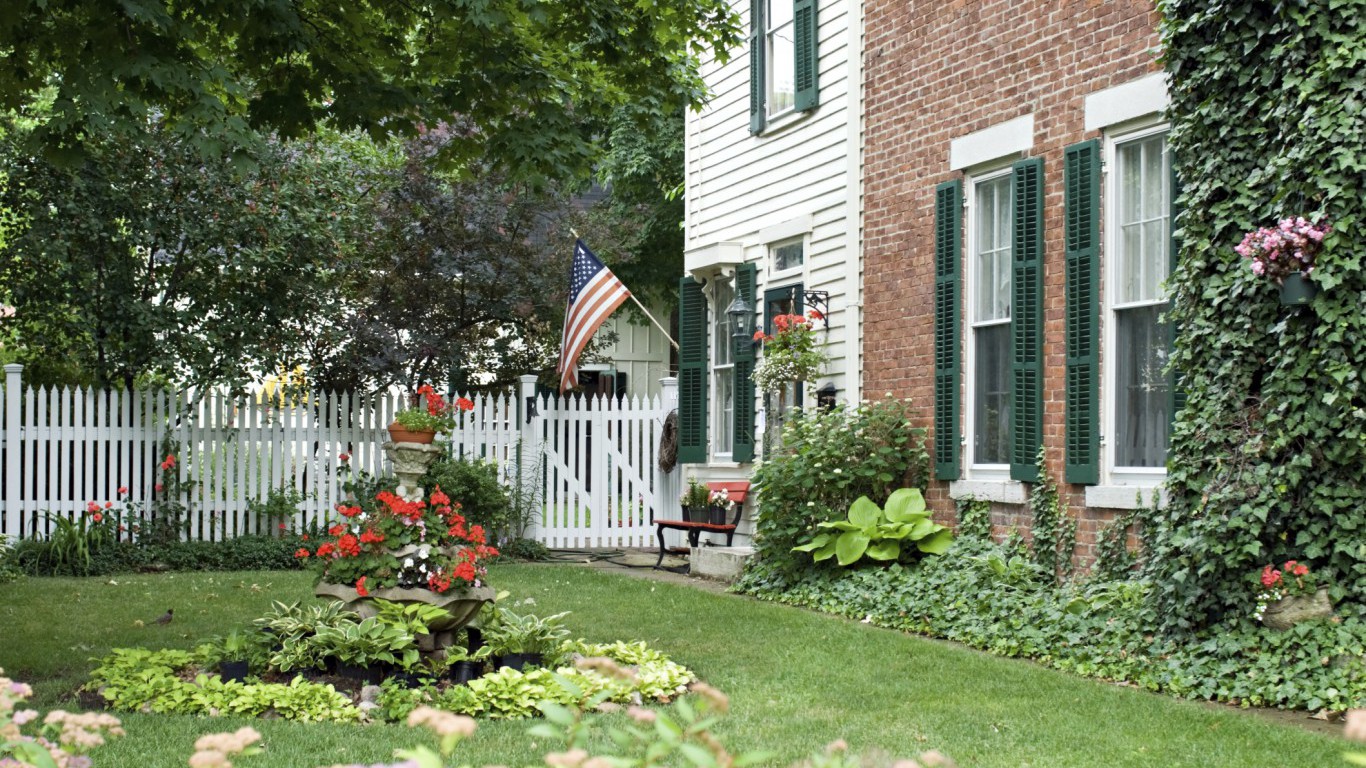
39. Ohio
> Increase in Alzheimer’s, 2017-2025: 19.0%
> Pct. of 65+ pop. with Alzheimer’s: 11.4% (24th lowest)
> Population 65+: 15.8% (17th highest)
> Pct. of 65+ pop. in good health: 75.5% (20th lowest)
> Avg. retirement income: $23,577 (25th highest)
The number of people with Alzheimer’s in Ohio is predicted to rise by 19% over the next eight years. Like every other state, Ohio’s Medicaid costs for elderly Alzheimer’s patients will increase considerably, but the projected increase of 27.2% is much lower than the expected increase nationwide of 37.1%.
The Cleveland Clinic, which does an annual analysis of Alzheimer’s disease drug development, said in June that unless the drug development process speeds up, the United States will likely not meet by 2025 the Alzheimer’s treatment goals laid out by the Obama administration.
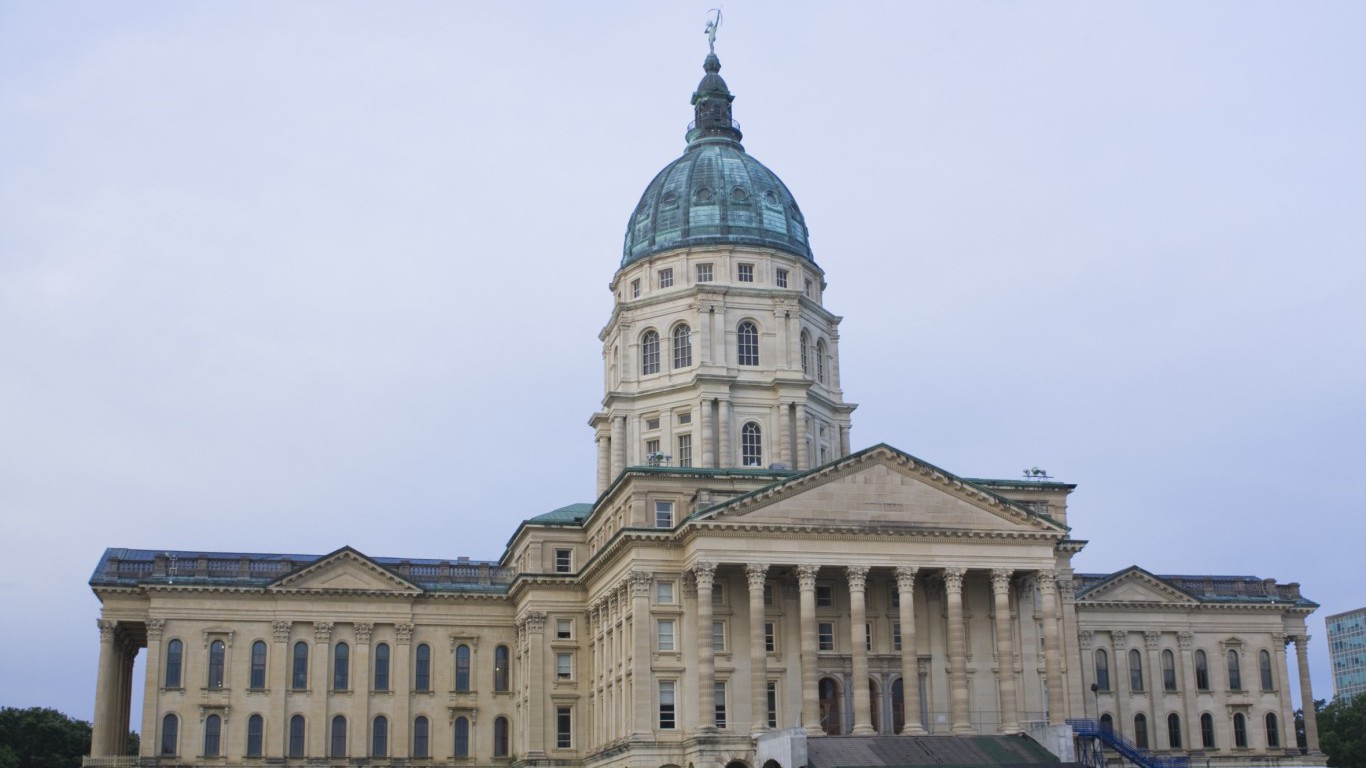
38. Kansas
> Increase in Alzheimer’s, 2017-2025: 19.2%
> Pct. of 65+ pop. with Alzheimer’s: 12.2% (12th highest)
> Population 65+: 14.6% (16th lowest)
> Pct. of 65+ pop. in good health: 76.2% (24th lowest)
> Avg. retirement income: $20,990 (6th lowest)
Just as the number of people with Alzheimer’s in Kansas is expected to increase at a slower than average rate, cost increases are expected to keep pace with the nation. The state’s Medicaid costs to care for those with Alzheimer’s is forecast to rise at a slightly lower than average rate of 30.7%
Alzheimer’s disproportionately affects the elderly and retired. The average annual retirement income in Kansas is only about $21,000, well below most states. The value of unpaid Alzheimer’s care in the state in 2016, primarily from friends and family members, topped $2 billion.

37. Oklahoma
> Increase in Alzheimer’s, 2017-2025: 20.6%
> Pct. of 65+ pop. with Alzheimer’s: 10.9% (15th lowest)
> Population 65+: 14.7% (20th lowest)
> Pct. of 65+ pop. in good health: 69.7% (8th lowest)
> Avg. retirement income: $21,168 (9th lowest)
Alzheimer’s disease claimed 1,227 lives in Oklahoma in 2014, a 92% increase in Alzheimer’s deaths since 2000. The mortality rate that year, at 31.6 deaths for every 100,000 state residents, was higher than the national rate of 29.3 per 100,000 people. Absent a major treatment breakthrough, that number will only continue to climb as the number of Alzheimer’s patients in the state is projected to increase by over 20% in the next eight years.
[in-text-ad-2]

36. Nebraska
> Increase in Alzheimer’s, 2017-2025: 21.2%
> Pct. of 65+ pop. with Alzheimer’s: 11.8% (16th highest)
> Population 65+: 14.7% (18th lowest)
> Pct. of 65+ pop. in good health: 79.5% (9th highest)
> Avg. retirement income: $22,322 (18th lowest)
With 515 deaths from Alzheimer’s in Nebraska in 2014, the disease was the sixth leading cause of death in the state that year. Alzheimer’s patients are typically elderly and require living assistance. In Nebraska, nearly 30% of the 65 and older population live alone, one of the largest shares of any state.

35. Connecticut
> Increase in Alzheimer’s, 2017-2025: 21.3%
> Pct. of 65+ pop. with Alzheimer’s: 13.3% (2nd highest)
> Population 65+: 15.7% (19th highest)
> Pct. of 65+ pop. in good health: 77.2% (20th highest)
> Avg. retirement income: $27,470 (10th highest)
The Alzheimer’s Association forecasts a 30.8% increase in Alzheimer’s-related Medicaid costs in Connecticut from 2017 to 2025. The number of people with the disease will climb 21.3% over the same period. Both increases are slightly lower than average changes across all states.
[in-text-ad]

34. Arkansas
> Increase in Alzheimer’s, 2017-2025: 21.8%
> Pct. of 65+ pop. with Alzheimer’s: 11.5% (22nd highest)
> Population 65+: 16.1% (14th highest)
> Pct. of 65+ pop. in good health: 68.7% (6th lowest)
> Avg. retirement income: $19,147 (3rd lowest)
Arkansas had the seventh highest Alzheimer’s death rate in America in 2014. The number of deaths attributed to Alzheimer’s in the state, at 1,193, was a 177% increase since 2000. Without a major medical breakthrough, the number of deaths will likely continue to climb as the number of Arkansas residents with the disease is projected to increase by nearly 22% by 2025.
The projected increase is well below that of most states, however. The relatively slow projected increase in Alzheimer’s cases is largely explained by the slow growth in the state’s 65 and over population, which is projected to grow by just 18.8% by 2025, well below the 25.2% national average projection.
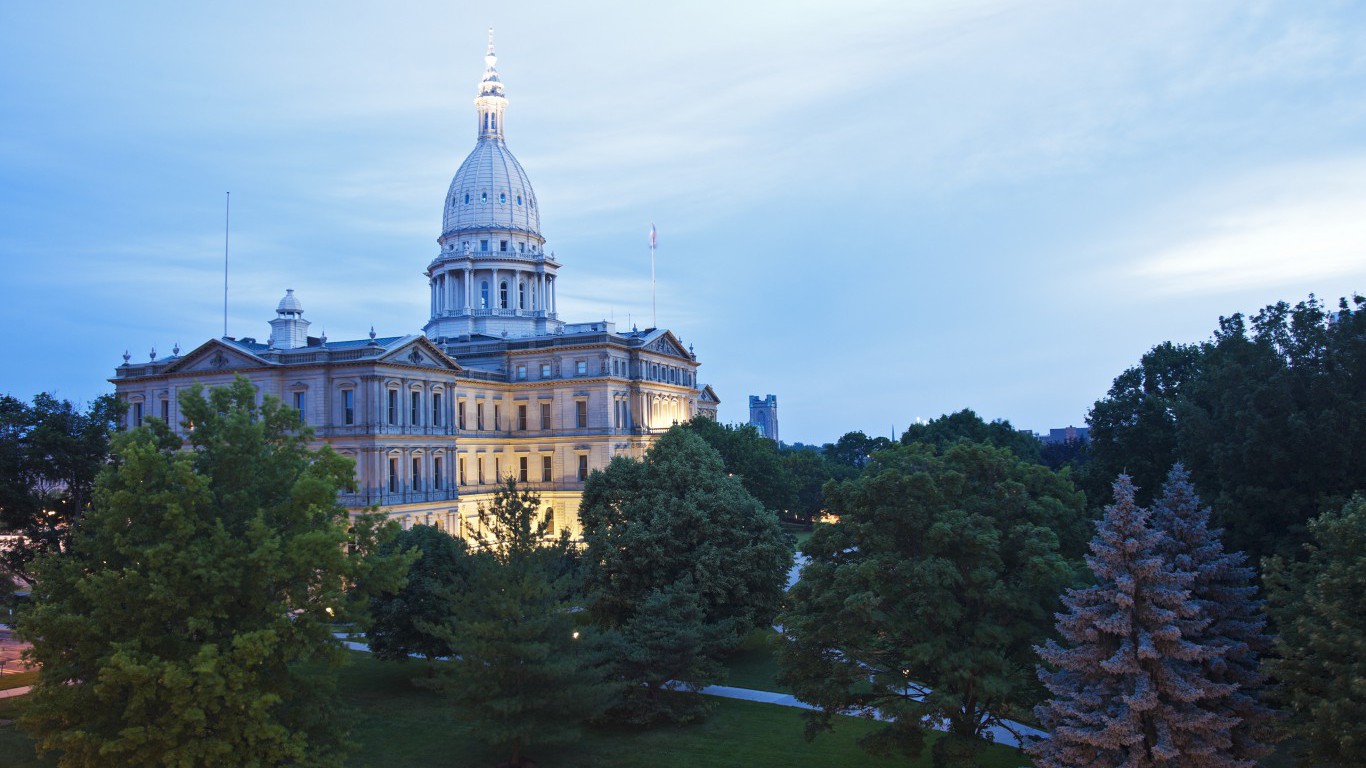
33. Michigan
> Increase in Alzheimer’s, 2017-2025: 22.2%
> Pct. of 65+ pop. with Alzheimer’s: 11.5% (25th highest)
> Population 65+: 15.8% (18th highest)
> Pct. of 65+ pop. in good health: 77.7% (18th highest)
> Avg. retirement income: $22,429 (20th lowest)
In Michigan, 3,349 people died from Alzheimer’s disease in 2014, double the number of Alzheimer’s deaths in 2000. The state’s Alzheimer’s mortality rate of 34 deaths per 100,000 people is slightly higher than the comparable nationwide rate of 29 deaths per 100,000 Americans. Last August, researchers from various Michigan institutions announced they were getting $9 million in Alzheimer’s research grants over the next five years from the National Institutes of Health.
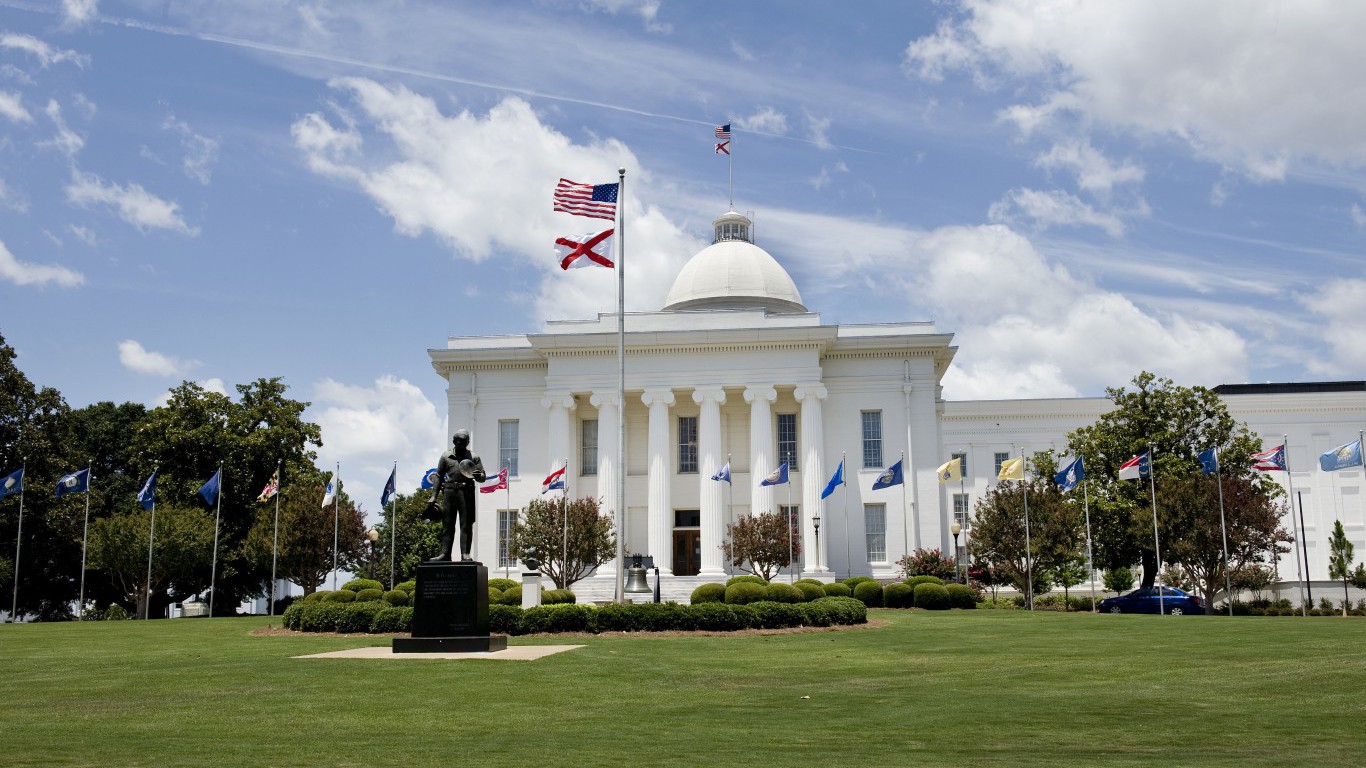
32. Alabama
> Increase in Alzheimer’s, 2017-2025: 22.2%
> Pct. of 65+ pop. with Alzheimer’s: 11.8% (17th highest)
> Population 65+: 15.7% (20th highest)
> Pct. of 65+ pop. in good health: 67.9% (4th lowest)
> Avg. retirement income: $22,749 (21st lowest)
In Alabama, 1,885 deaths were attributed to Alzheimer’s disease in 2014, more than double the Alzheimer’s deaths in 2000. As the number of people with Alzheimer’s in the state climbs by 22.2% over the next eight years, Medicaid spending on elderly state residents with the disease will go up 37%, in line with the average growth expected nationwide.
[in-text-ad-2]
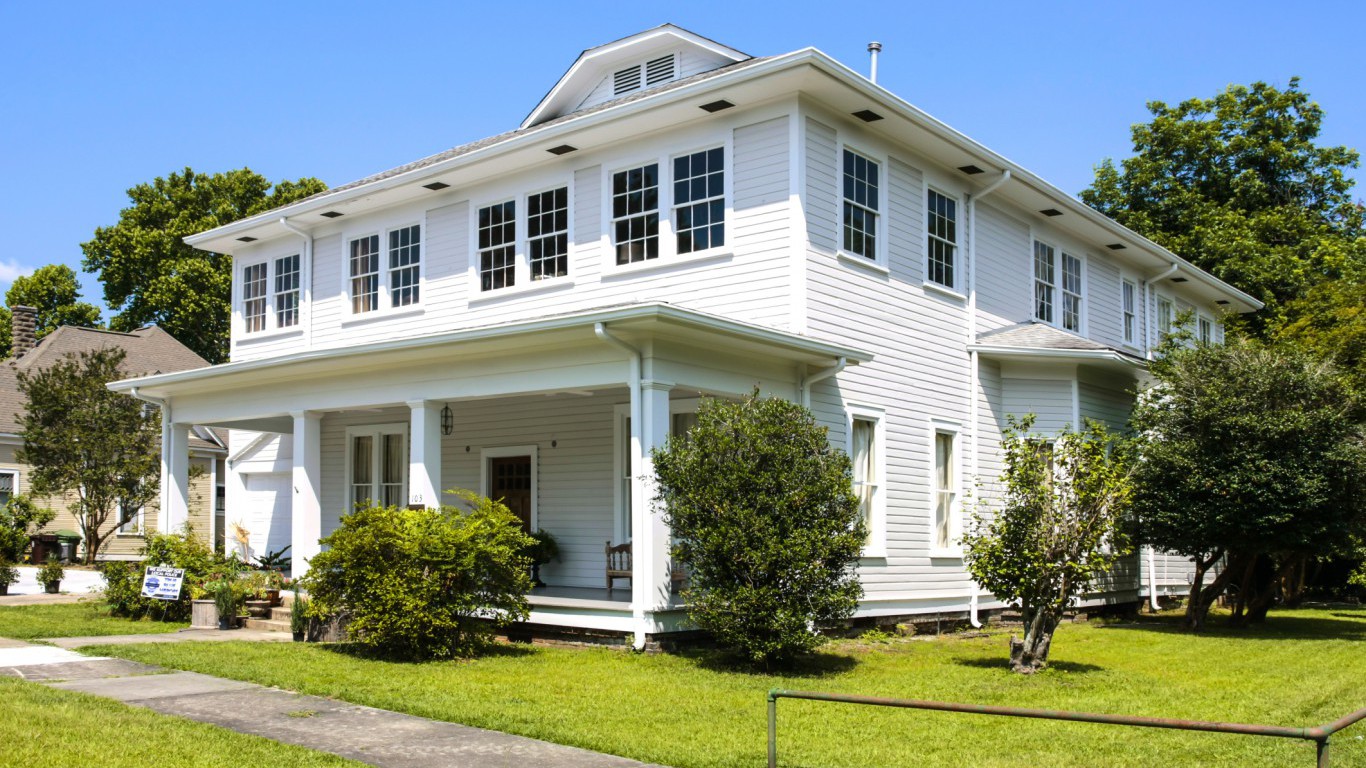
31. Mississippi
> Increase in Alzheimer’s, 2017-2025: 22.6%
> Pct. of 65+ pop. with Alzheimer’s: 12.0% (15th highest)
> Population 65+: 14.7% (21st lowest)
> Pct. of 65+ pop. in good health: 62.8% (the lowest)
> Avg. retirement income: $21,357 (11th lowest)
According to a 2015 CDC survey, one in eight Mississippians 45 or older, report signs of cognitive decline. Alzheimer’s disease claimed 1,098 lives in Mississippi in 2014, a 148% increase since 2000. By 2025, the number of Mississippians with the disease is projected to increase by 22.6% and Medicaid spending on the state’s elderly residents with the disease is projected to increase by 31.8%. For reference, the number of people 65 and older with Alzheimer’s nationwide is expected to increase by nearly 35% by 2025, and Medicaid costs for individuals with the disease are projected to increase by 37.1%.

30. Kentucky
> Increase in Alzheimer’s, 2017-2025: 22.9%
> Pct. of 65+ pop. with Alzheimer’s: 10.4% (7th lowest)
> Population 65+: 15.2% (25th lowest)
> Pct. of 65+ pop. in good health: 68.7% (6th lowest)
> Avg. retirement income: $21,578 (16th lowest)
There were 1,523 deaths from Alzheimer’s disease in Kentucky in 2014, or 34.5 for every 100,000 people, higher than the national Alzheimer’s mortality rate of 29.3 per 100,000 people. Just over 10% of Kentucky’s 65 and over population has Alzheimer’s, the seventh lowest percentage of all states. Compared with states where relatively few elderly have the disease, Kentucky does better than most in providing care for Alzheimer’s patients. There are 3.9 caregivers per person with Alzheimer’s, the fifth highest ratio of all states.
[in-text-ad]
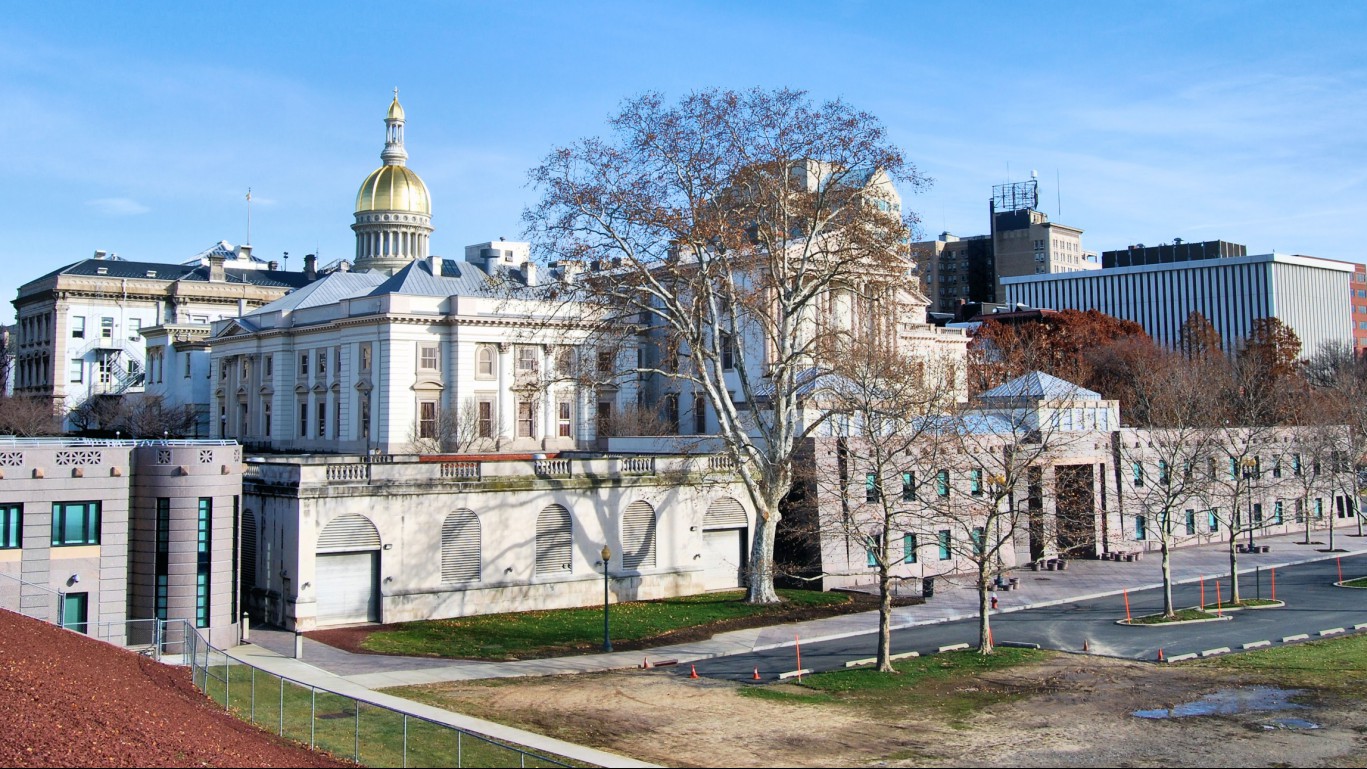
29. New Jersey
> Increase in Alzheimer’s, 2017-2025: 23.5%
> Pct. of 65+ pop. with Alzheimer’s: 12.7% (8th highest)
> Population 65+: 15.0% (23rd lowest)
> Pct. of 65+ pop. in good health: 76.1% (23rd lowest)
> Avg. retirement income: $27,612 (9th highest)
There were 22 Alzheimer’s deaths for every 100,000 New Jersey residents in 2014, a lower mortality rate than in the vast majority of states. New Jersey’s Alzheimer’s death rate will almost certainly increase, but it will also likely remain below average. The number of Garden State residents living with the disease is projected to increase by 23.5%, slower than the average across all states.

28. Massachusetts
> Increase in Alzheimer’s, 2017-2025: 25.0%
> Pct. of 65+ pop. with Alzheimer’s: 11.5% (24th highest)
> Population 65+: 15.4% (25th highest)
> Pct. of 65+ pop. in good health: 78.6% (12th highest)
> Avg. retirement income: $27,438 (11th highest)
The Massachusetts Alzheimer’s Disease Research Center, a collaboration of Massachusetts General Hospital and Harvard Medical School, conducts extensive research, training, and outreach programs. Currently, annual Medicaid costs of caring for people with Alzheimer’s disease in Massachusetts are estimated at $1.6 billion. By 2025, the cost is projected to climb to roughly $2 billion.

27. Washington
> Increase in Alzheimer’s, 2017-2025: 27.3%
> Pct. of 65+ pop. with Alzheimer’s: 10.6% (9th lowest)
> Population 65+: 14.5% (13th lowest)
> Pct. of 65+ pop. in good health: 79.8% (7th highest)
> Avg. retirement income: $24,903 (20th highest)
Alzheimer’s disease was the third leading cause of death in Washington in 2014, with 3,344 deaths contributing to the third highest Alzheimer’s death rate of any state. Gov. Jay Inslee announced on Alzheimer Association’s Advocacy Day in February 2016 the state’s first plan to address Alzheimer’s and dementia.
[in-text-ad-2]

26. Tennessee
> Increase in Alzheimer’s, 2017-2025: 27.3%
> Pct. of 65+ pop. with Alzheimer’s: 10.8% (12th lowest)
> Population 65+: 15.4% (24th highest)
> Pct. of 65+ pop. in good health: 69.0% (7th lowest)
> Avg. retirement income: $21,884 (17th lowest)
There were 2,672 deaths from Alzheimer’s disease in Tennessee in 2014, a 161% increase from 2000. Alzheimer’s deaths that year amounted to about 41 deaths for every 100,000 people in the state, the sixth highest Alzheimer’s death rate of any state. While the number of state residents living with Alzheimer’s is projected to increase by 27.3% in the next eight years, slower than the national projected increase of nearly 35%, Medicaid costs related to the disease are projected to increase by 42.1%, significantly higher than the average projected increase of $37.1%.

25. Delaware
> Increase in Alzheimer’s, 2017-2025: 27.8%
> Pct. of 65+ pop. with Alzheimer’s: 11.2% (20th lowest)
> Population 65+: 17.0% (7th highest)
> Pct. of 65+ pop. in good health: 76.8% (25th highest)
> Avg. retirement income: $26,643 (12th highest)
In Delaware, the Alzheimer’s Association forecasts a 43.1% increase in Medicaid costs related to caring for those with Alzheimer’s disease by 2025. Delaware’s elderly residents comprise 17% of the population, the seventh highest share of all states. The larger elderly population helps explain the higher incidence of Alzheimer’s disease among Delaware’s general population compared to other states. Still, among the elderly, 11.2% of 65 and over Delaware residents have the disease, a lower incidence than the average across all states.
[in-text-ad]

24. Louisiana
> Increase in Alzheimer’s, 2017-2025: 29.4%
> Pct. of 65+ pop. with Alzheimer’s: 13.0% (6th highest)
> Population 65+: 14.0% (7th lowest)
> Pct. of 65+ pop. in good health: 64.2% (2nd lowest)
> Avg. retirement income: $21,379 (12th lowest)
There were 1,670 deaths in Louisiana from Alzheimer’s disease in 2014, approximately double the number of Alzheimer’s deaths in 2000. Over the next eight years, the number of elderly people with disease is projected to climb 29.4% in Louisiana, a larger increase than average. Alzheimer’s is largely confined to older population, and Louisiana’s elderly are not particularly healthy to begin with. Only 64.2% of the state’s 65 and older population are in good health, the second smallest share in the country.
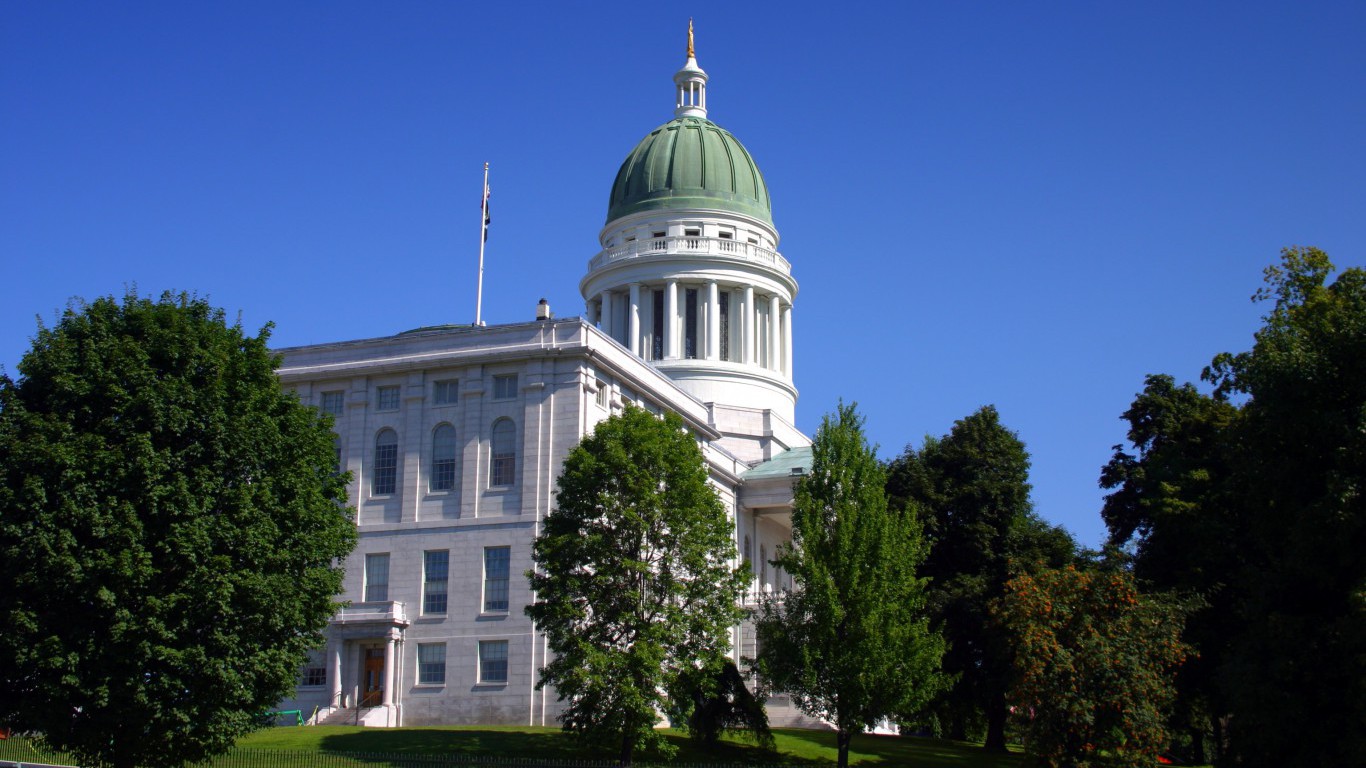
23. Maine
> Increase in Alzheimer’s, 2017-2025: 29.6%
> Pct. of 65+ pop. with Alzheimer’s: 10.8% (11th lowest)
> Population 65+: 18.8% (2nd highest)
> Pct. of 65+ pop. in good health: 79.7% (8th highest)
> Avg. retirement income: $21,489 (14th lowest)
Alzheimer’s disease claimed the lives of 434 Maine residents in 2014, which amounted to an Alzheimer’s death rate of 32.6 per 100,000, slightly higher than average. By 2025, an anticipated 35,000 people in Maine will be living with the disease, a 29.6% increase from 2017. This past May, the Jackson Laboratory in Bal Harbor announced it was receiving a $2.7 million U.S. government grant for a five-year project researching Alzheimer’s prevention methods.

22. Hawaii
> Increase in Alzheimer’s, 2017-2025: 29.6%
> Pct. of 65+ pop. with Alzheimer’s: 11.4% (21st lowest)
> Population 65+: 16.6% (8th highest)
> Pct. of 65+ pop. in good health: 82.3% (2nd highest)
> Avg. retirement income: $29,264 (5th highest)
In Hawaii, 326 people died from Alzheimer’s disease in 2014, a 176% increase from 2000. The number of people in the state with the disease will climb 29.6% to approximately 35,000 by 2025 according to the Alzheimer’s Association. Alzheimer’s is projected to increase in Hawaii faster than in most states largely because the state has a large 65 and older population, for whom the risk of Alzheimer’s will gradually increase over time. There are also relatively few individuals with the disease currently. Close to 17% of Hawaiians are 65 and over, the eighth highest share of all states.
[in-text-ad-2]

21. Maryland
> Increase in Alzheimer’s, 2017-2025: 30.0%
> Pct. of 65+ pop. with Alzheimer’s: 11.8% (18th highest)
> Population 65+: 14.1% (9th lowest)
> Pct. of 65+ pop. in good health: 77.6% (19th highest)
> Avg. retirement income: $31,771 (2nd highest)
Medicaid costs of caring for elderly Alzheimer’s patients will climb 42.8% in Maryland by 2025. The medical costs will increase at a faster rate than the spread of the disease. The number of people with the disease will increase from 100,000 today to a projected 130,000 in 2025 — a 30% rise. The Alzheimer’s mortality rate in Maryland is one of the lowest in the country, at just 15.6 deaths per 100,000 people.

20. Minnesota
> Increase in Alzheimer’s, 2017-2025: 30.4%
> Pct. of 65+ pop. with Alzheimer’s: 11.4% (25th lowest)
> Population 65+: 14.7% (17th lowest)
> Pct. of 65+ pop. in good health: 80.2% (6th highest)
> Avg. retirement income: $22,786 (23rd lowest)
Alzheimer’s disease was the sixth leading cause of death in Minnesota, claiming 1,628 lives in 2014. The number of people with the disease is projected to climb 30.4%, from 92,000 in 2017 to 120,000 in 2025. Medicaid costs related to treating the disease among the state’s elderly population are projected to increase by 35.1%, from $781 million to more than $1 billion over the same period. The increase is still below the national average increase in Medicaid spending projection of 37.1%.
[in-text-ad]

19. North Carolina
> Increase in Alzheimer’s, 2017-2025: 31.3%
> Pct. of 65+ pop. with Alzheimer’s: 10.6% (8th lowest)
> Population 65+: 15.1% (24th lowest)
> Pct. of 65+ pop. in good health: 70.8% (9th lowest)
> Avg. retirement income: $22,797 (24th lowest)
There are about 459,000 Alzheimer’s and dementia caregivers in North Carolina, or three for every one Alzheimer’s patient. In addition, friends and family members of those afflicted with the disease in the state put in over 520 million hours of unpaid care in 2016 alone. North Carolina has a rapidly growing elderly population, and partially as a result, state lawmakers implemented policies in 2016 to benefit elderly residents with the disease as well as their caregivers.
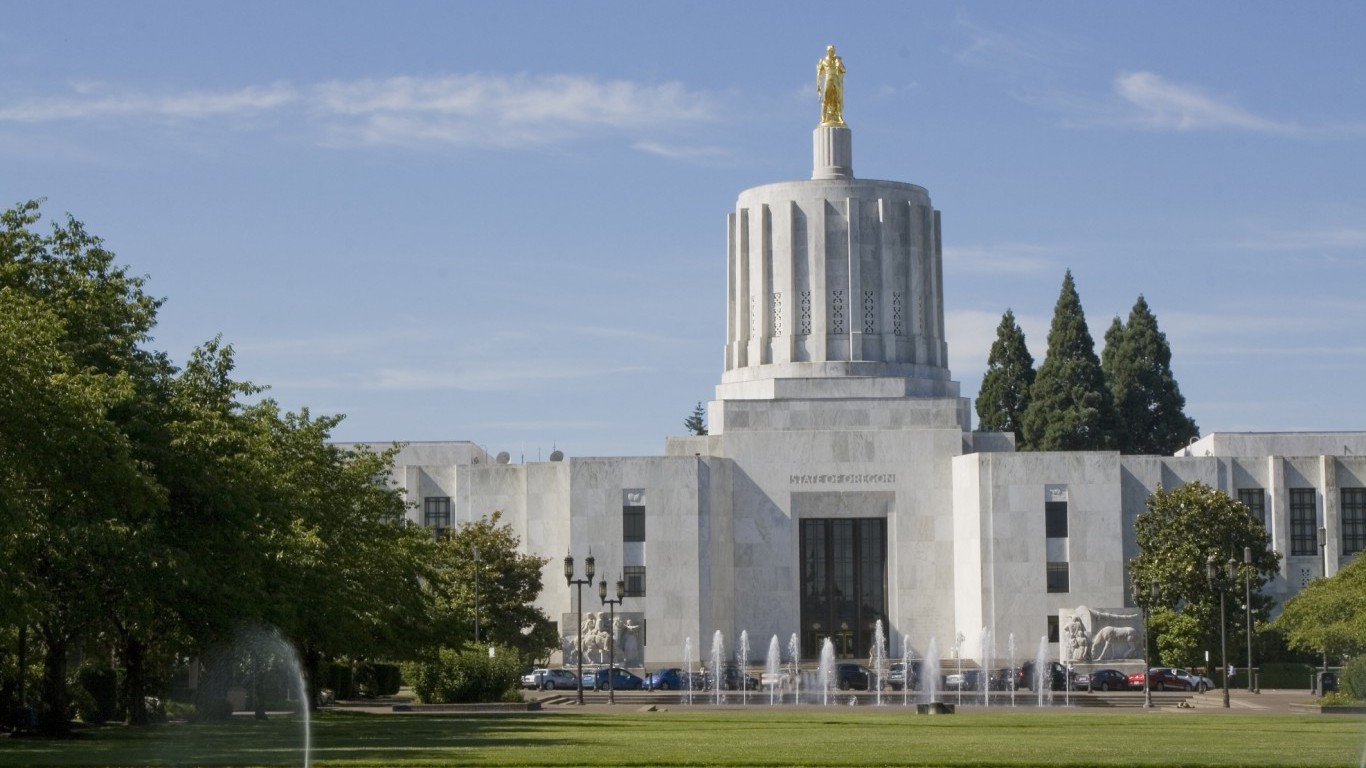
18. Oregon
> Increase in Alzheimer’s, 2017-2025: 33.3%
> Pct. of 65+ pop. with Alzheimer’s: 9.5% (the lowest)
> Population 65+: 16.4% (11th highest)
> Pct. of 65+ pop. in good health: 77.8% (17th highest)
> Avg. retirement income: $25,598 (18th highest)
The estimated annual Medicaid costs for caring for people 65 and older with Alzheimer’s disease in Oregon are currently $222 million. Costs are projected to climb 38.6% by 2025 — inline with the average increase expected nationally. In April, researchers at Oregon State University said they found that a compound called rapamycin could help fight neurologic damage caused by such diseases as Alzheimer’s.
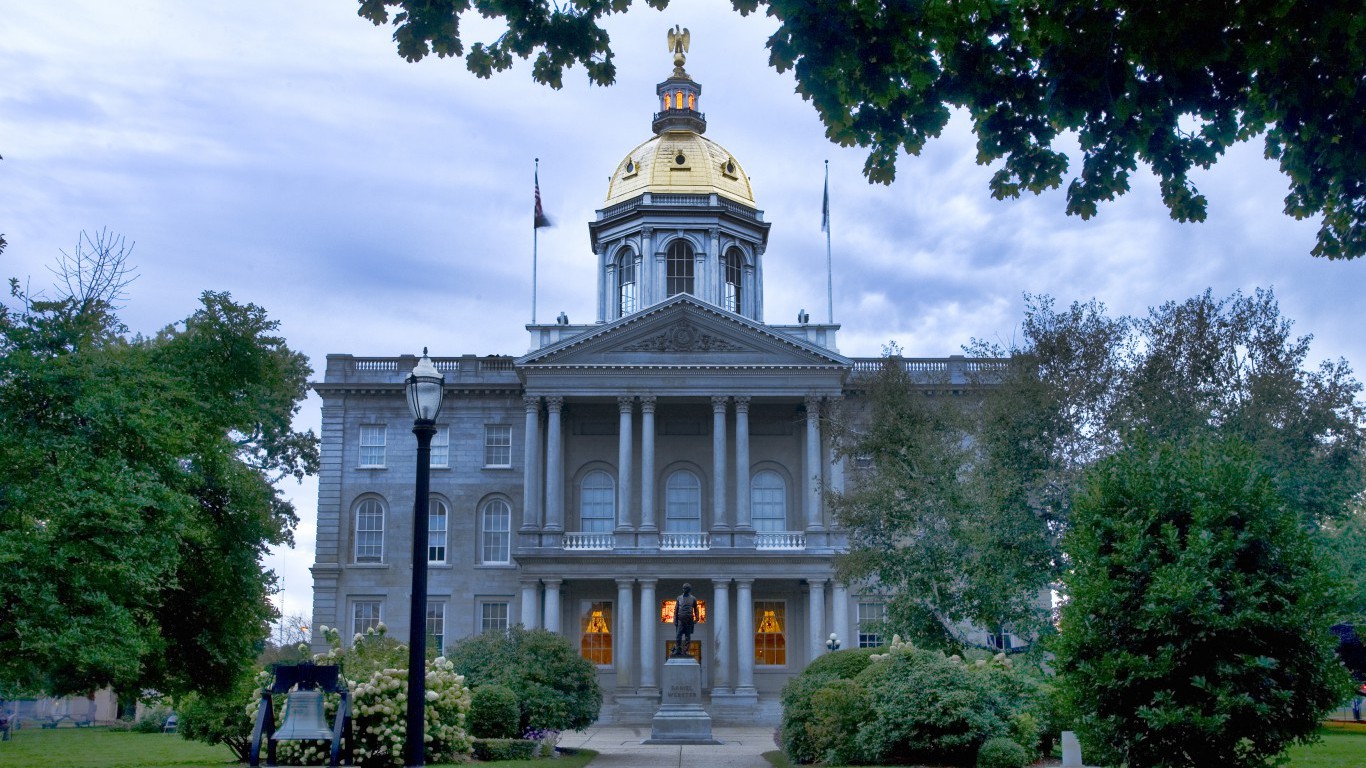
17. New Hampshire
> Increase in Alzheimer’s, 2017-2025: 33.3%
> Pct. of 65+ pop. with Alzheimer’s: 11.0% (16th lowest)
> Population 65+: 16.4% (9th highest)
> Pct. of 65+ pop. in good health: 82.6% (the highest)
> Avg. retirement income: $22,976 (25th lowest)
Some 24,000 New Hampshire residents are living with Alzheimer’s. By 2025, this number is projected to increase by a third. Alzheimer’s primarily affects the elderly, and New Hampshire’s elderly population comprises 16.4% of state residents, the ninth highest share of all states. New Hampshire also has the healthiest elderly population of any state. Some 82.6% of state residents 65 and older are in good health compared to 74.5% of the nation’s elderly.
[in-text-ad-2]

16. Colorado
> Increase in Alzheimer’s, 2017-2025: 33.3%
> Pct. of 65+ pop. with Alzheimer’s: 9.7% (2nd lowest)
> Population 65+: 13.0% (5th lowest)
> Pct. of 65+ pop. in good health: 82.1% (3rd highest)
> Avg. retirement income: $28,761 (6th highest)
Alzheimer’s primarily affects the elderly, and Colorado is a relatively young state. Elderly state residents comprise 13.0% of the population, the fifth lowest share, and only 9.7% of these individuals have Alzheimer’s, the second lowest share. At the current rate, the state’s elderly population will grow by 32.7% by 2025, the second fastest rate compared with other states and well above the national average rate of approximately 25%.
The state appears better equipped than most to handle the projected increase in Alzheimer’s patients. For every Colorado resident afflicted with Alzheimer’s, there are 3.5 caregivers — one of the highest caregiver to patient ratios of any state.
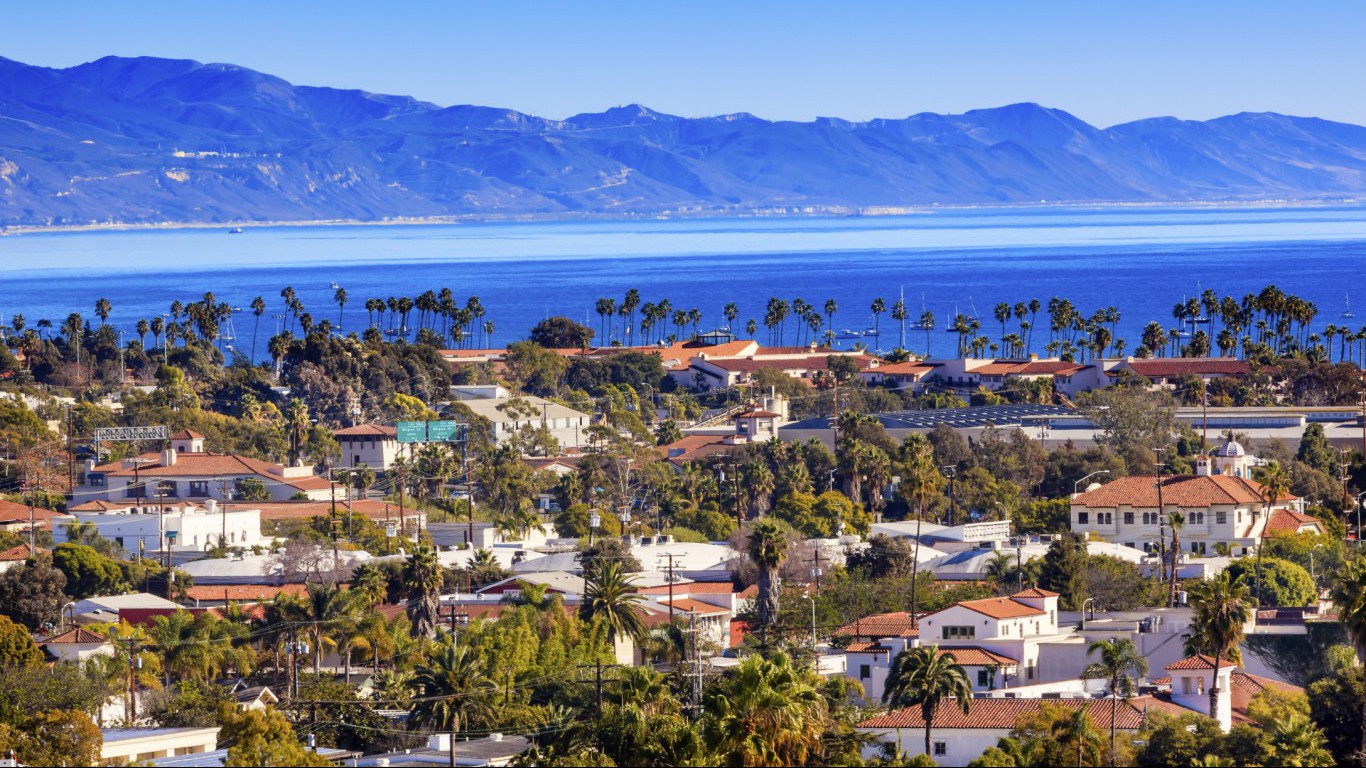
15. California
> Increase in Alzheimer’s, 2017-2025: 33.3%
> Pct. of 65+ pop. with Alzheimer’s: 12.1% (13th highest)
> Population 65+: 13.3% (6th lowest)
> Pct. of 65+ pop. in good health: 74.8% (19th lowest)
> Avg. retirement income: $30,503 (3rd highest)
California, the most populous state, had 12,644 deaths attributed to Alzheimer’s disease in 2014, more than any other state. California has 1.6 million caregivers for Alzheimer’s, the most of any state. The number of people suffering from the disease is expected to climb to 840,000 by 2025, a 33.3% increase.
The average retirement income in California of $30,503 a year is third highest. Still, Medicaid spending on Alzheimer’s patients is expected to grow by 46.8% by 2025, well above the average increase of 37.1% expected nationwide.
[in-text-ad]

14. Montana
> Increase in Alzheimer’s, 2017-2025: 35.0%
> Pct. of 65+ pop. with Alzheimer’s: 11.2% (19th lowest)
> Population 65+: 17.3% (5th highest)
> Pct. of 65+ pop. in good health: 78.4% (13th highest)
> Avg. retirement income: $24,060 (23rd highest)
Elderly residents comprise 17.3% of Montana’s population, the fifth highest share of all states. Relatively few, 11.2%, 65 and older individuals have been diagnosed with Alzheimer’s. The 35% projected increase in the incidence of the disease by 2025 is higher than in most states but also roughly in line with the national average projection.
A number of states have implemented plans for tackling the Alzheimer’s issue. The official Montana Alzheimer’s disease plan seeks to expand access to person-centered care for those with Alzheimer’s and dementia and their loved ones.

13. Virginia
> Increase in Alzheimer’s, 2017-2025: 35.7%
> Pct. of 65+ pop. with Alzheimer’s: 11.8% (19th highest)
> Population 65+: 14.2% (10th lowest)
> Pct. of 65+ pop. in good health: 76.9% (24th highest)
> Avg. retirement income: $30,085 (4th highest)
The incidence of Alzheimer’s in Virginia is expected to increase by 35.7% by 2025, a higher rate than in most states and slightly faster than the national average projection. Medicaid costs for caring for those with Alzheimer’s disease, however, are forecast to rise between much faster between 2017 and 2025 than the projected increase nationwide, at 48.7% versus 37.1%.

12. Georgia
> Increase in Alzheimer’s, 2017-2025: 35.7%
> Pct. of 65+ pop. with Alzheimer’s: 10.7% (10th lowest)
> Population 65+: 12.8% (4th lowest)
> Pct. of 65+ pop. in good health: 73.9% (16th lowest)
> Avg. retirement income: $24,461 (21st highest)
The number of people with Alzheimer’s disease in Georgia will increase by 35.7% by 2025. For individuals between the ages of 75 and 84 the incidence will rise by 30% by 2025. Medicaid costs of caring for those with Alzheimer’s are expected to soar from $1.05 billion in 2017 to $1.54 billion by 2025. This 48.7% increase is one of the largest of all states.
As is almost always the case in states where Alzheimer’s disease is soaring, the projected increase over the next decade in Georgia’s elderly population of approximately 30% is one of the highest in the nation.
[in-text-ad-2]
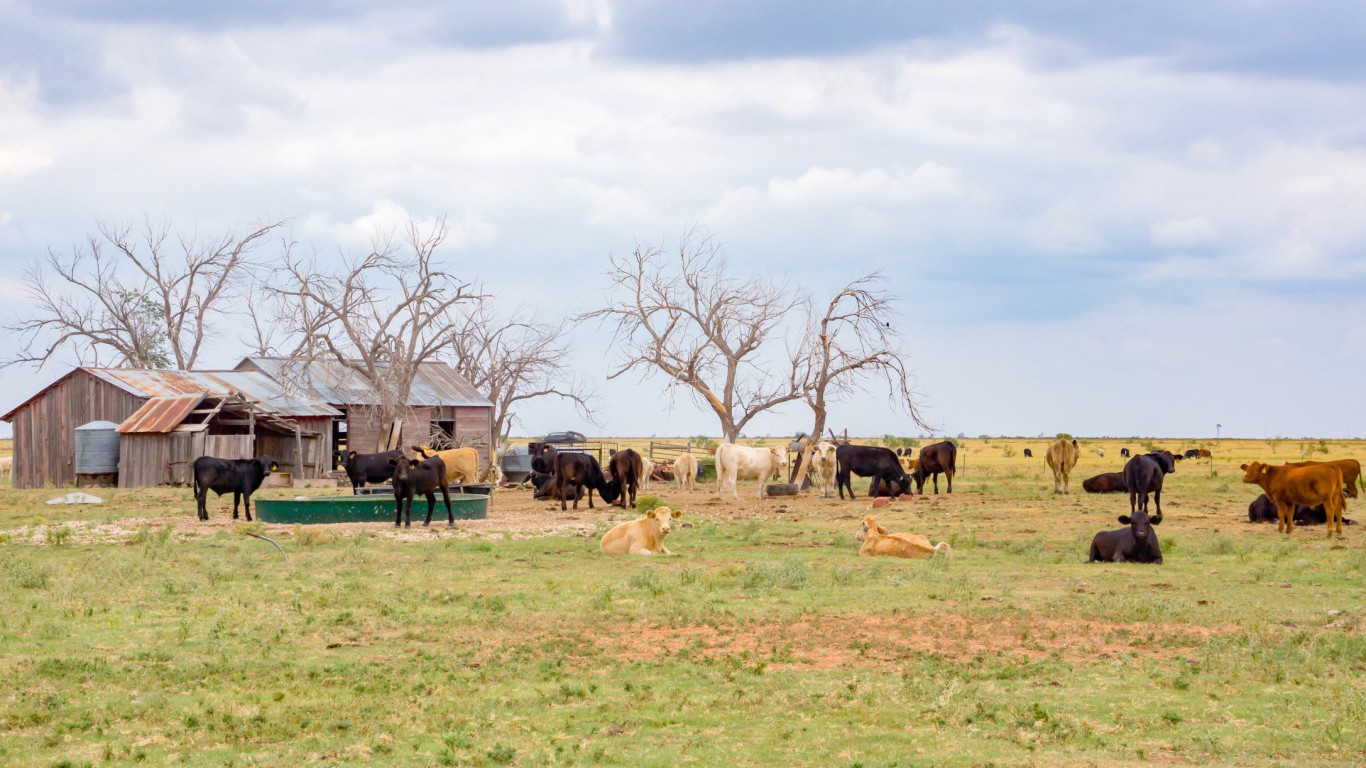
11. Texas
> Increase in Alzheimer’s, 2017-2025: 36.1%
> Pct. of 65+ pop. with Alzheimer’s: 11.2% (18th lowest)
> Population 65+: 11.7% (3rd lowest)
> Pct. of 65+ pop. in good health: 73.2% (12th lowest)
> Avg. retirement income: $24,231 (22nd highest)
Texas had the second most deaths attributed to Alzheimer’s disease of any state, according to the Alzheimer’s Association in 2014, at 6,772. Adjusted to the population, the Alzheimer’s mortality rate was slightly over 25 per 100,000 people, much lower than the nationwide disease mortality rate of 29.3 per 100,000 people.
It is interesting to note that while Texas is expected to have the 11th highest increase in Alzheimer’s cases, at 36.1%, it has the third smallest share of 65 and over population, at 11.7% of state residents.

10. Idaho
> Increase in Alzheimer’s, 2017-2025: 37.5%
> Pct. of 65+ pop. with Alzheimer’s: 9.9% (4th lowest)
> Population 65+: 14.7% (19th lowest)
> Pct. of 65+ pop. in good health: 80.3% (5th highest)
> Avg. retirement income: $21,132 (7th lowest)
Largely as a consequence of the expected spike in Alzheimer’s cases, Medicaid costs of caring for those with Alzheimer’s disease will climb 47.8% in Idaho from 2017 to 2025. In the United States, some portion of medical costs in old age almost always come from personal and family savings, and low retirement incomes may also explain the large expected increase in Medicaid costs across the state. The typical retirement income in Idaho is currently $21,132 annually, the seventh lowest such income of all states.
[in-text-ad]
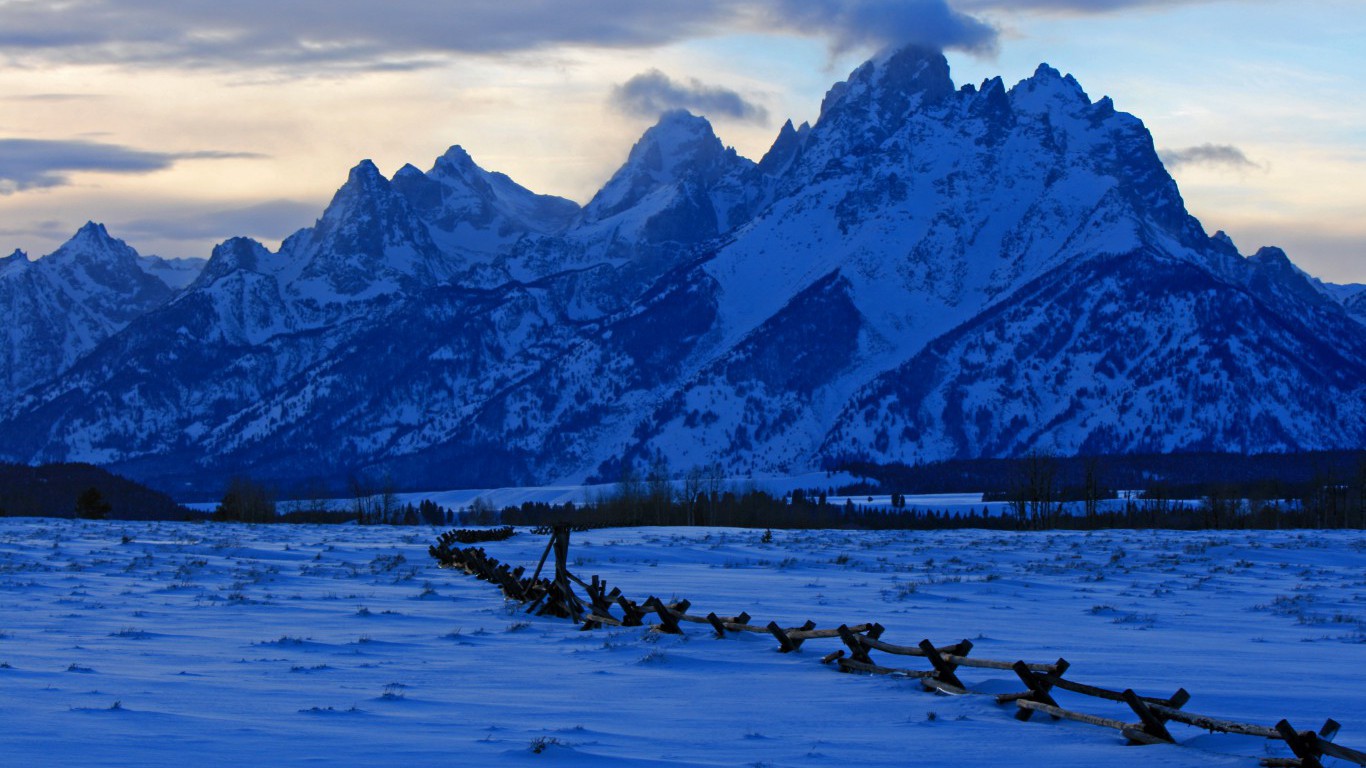
9. Wyoming
> Increase in Alzheimer’s, 2017-2025: 38.3%
> Pct. of 65+ pop. with Alzheimer’s: 11.4% (22nd lowest)
> Population 65+: 14.1% (8th lowest)
> Pct. of 65+ pop. in good health: 77.2% (20th highest)
> Avg. retirement income: $22,416 (19th lowest)
The number of people with Alzheimer’s disease in Wyoming will surge 38% by 2025, according to the Alzheimer’s Association. Large expected increases in Alzheimer’s almost always track closely with large projected increases in a state’s elderly population. Wyoming’s 65 and over population will grow from around 83,000 to approximately 116,800 by 2025, an increase of nearly 30%. By contrast, the elderly population will grow by roughly 25% nationwide over that time period. Medicaid costs in Wyoming are expected to climb even more, by 52.1% between 2017 and 2025.

8. Florida
> Increase in Alzheimer’s, 2017-2025: 38.5%
> Pct. of 65+ pop. with Alzheimer’s: 13.2% (3rd highest)
> Population 65+: 19.5% (the highest)
> Pct. of 65+ pop. in good health: 77.1% (22nd highest)
> Avg. retirement income: $25,845 (17th highest)
Florida’s elderly population will grow by approximately 25% by 2025, about average. But the state already has the largest share of elderly population of all states — nearly 1 in every 5 Florida residents are 65 or older. The state’s older residents will continue to age for many years, and the risk of Alzheimer’s, which is considerably more common among the oldest members of the nation’s elderly population, will also inevitably increase.
There were 510,000 people with Alzheimer’s disease in Florida in 2017, and Medicaid costs for caring for people with the disease totaled $2.33 billion. Florida has 1.1 million caregivers, the third most in the nation.

7. South Carolina
> Increase in Alzheimer’s, 2017-2025: 39.5%
> Pct. of 65+ pop. with Alzheimer’s: 10.8% (13th lowest)
> Population 65+: 16.2% (12th highest)
> Pct. of 65+ pop. in good health: 74.2% (17th lowest)
> Avg. retirement income: $23,744 (24th highest)
South Carolina has the eighth highest Alzheimer’s death rate in the United States, at 40.1 deaths for every 100,000 people. The Medicaid costs to care for South Carolinians diagnosed with Alzheimer’s, which reached $544 million in 2017, are projected to hit $793 million by 2025. The cost increase of 45.8% is among the highest of all states and well above the national average percentage increase of 37.1%.
[in-text-ad-2]
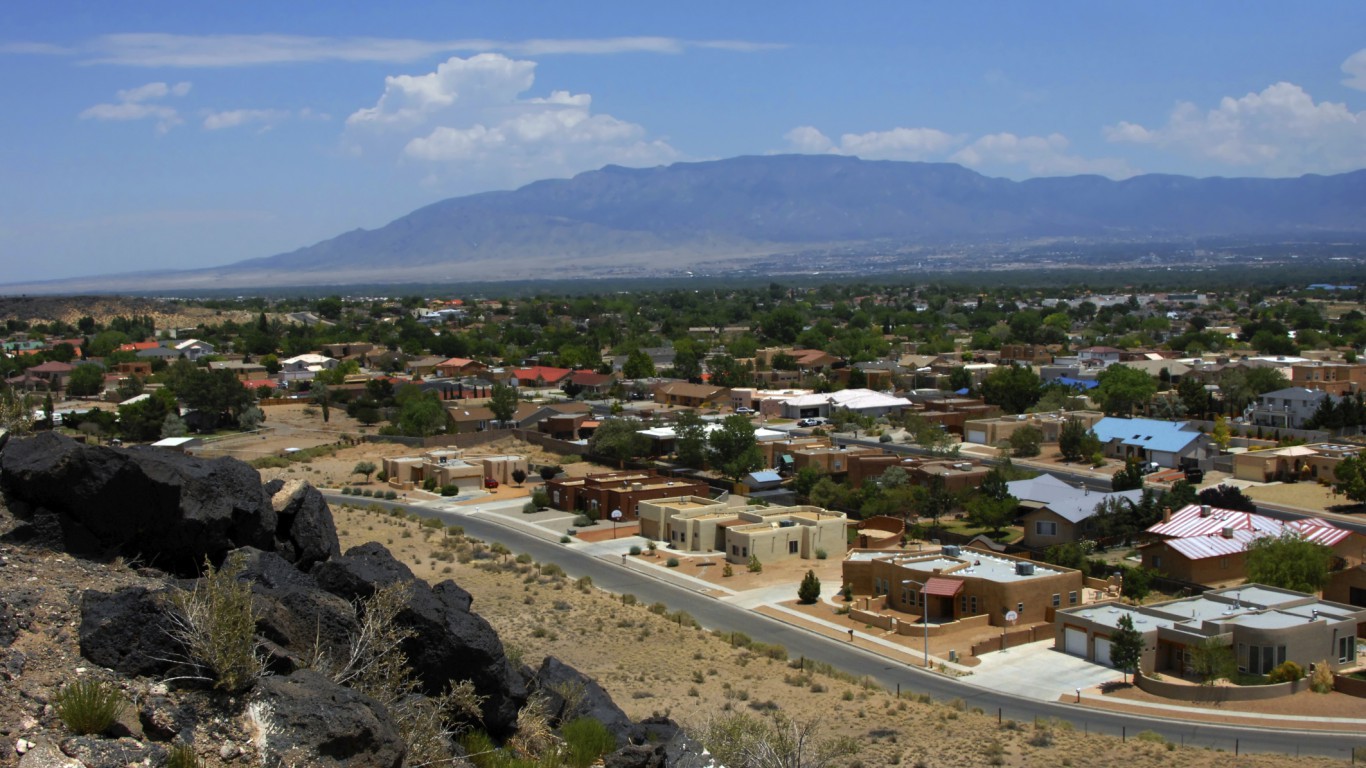
6. New Mexico
> Increase in Alzheimer’s, 2017-2025: 39.5%
> Pct. of 65+ pop. with Alzheimer’s: 11.5% (23rd highest)
> Population 65+: 15.9% (16th highest)
> Pct. of 65+ pop. in good health: 71.1% (10th lowest)
> Avg. retirement income: $26,637 (13th highest)
There are 38,000 elderly New Mexicans currently suffering from Alzheimer’s. By 2025, that number is expected to rise by nearly 40% to 53 thousand. The sharp rise will lead to higher medical costs. Medicaid spending on New Mexico residents 65 and over with Alzheimer’s or other dementias will rise by 52.4%, the fifth largest projected increase of all states.
Unlike many other states where Alzheimer’s disease cases will increase the most, the projected increase in New Mexico’s elderly population of 24.6% is slightly lower than the national average.

5. Utah
> Increase in Alzheimer’s, 2017-2025: 40.0%
> Pct. of 65+ pop. with Alzheimer’s: 9.7% (3rd lowest)
> Population 65+: 10.3% (2nd lowest)
> Pct. of 65+ pop. in good health: 79.5% (9th highest)
> Avg. retirement income: $26,526 (14th highest)
Utah has 30,000 people living with Alzheimer’s disease, based on Alzheimer’s Association data. Largely because the state’s population of 65 and over residents is relatively small and projected to grow at among the fastest rates, Alzheimer’s cases in the state are expected to soar by 40%, a rate of increase trailing just four other states. Elderly Utah residents comprise just 10.3% of the state’s population, second lowest share after only Alaska. And the number of elderly people living in Utah will grow by approximately 33%, third fastest compared with other states.
[in-text-ad]
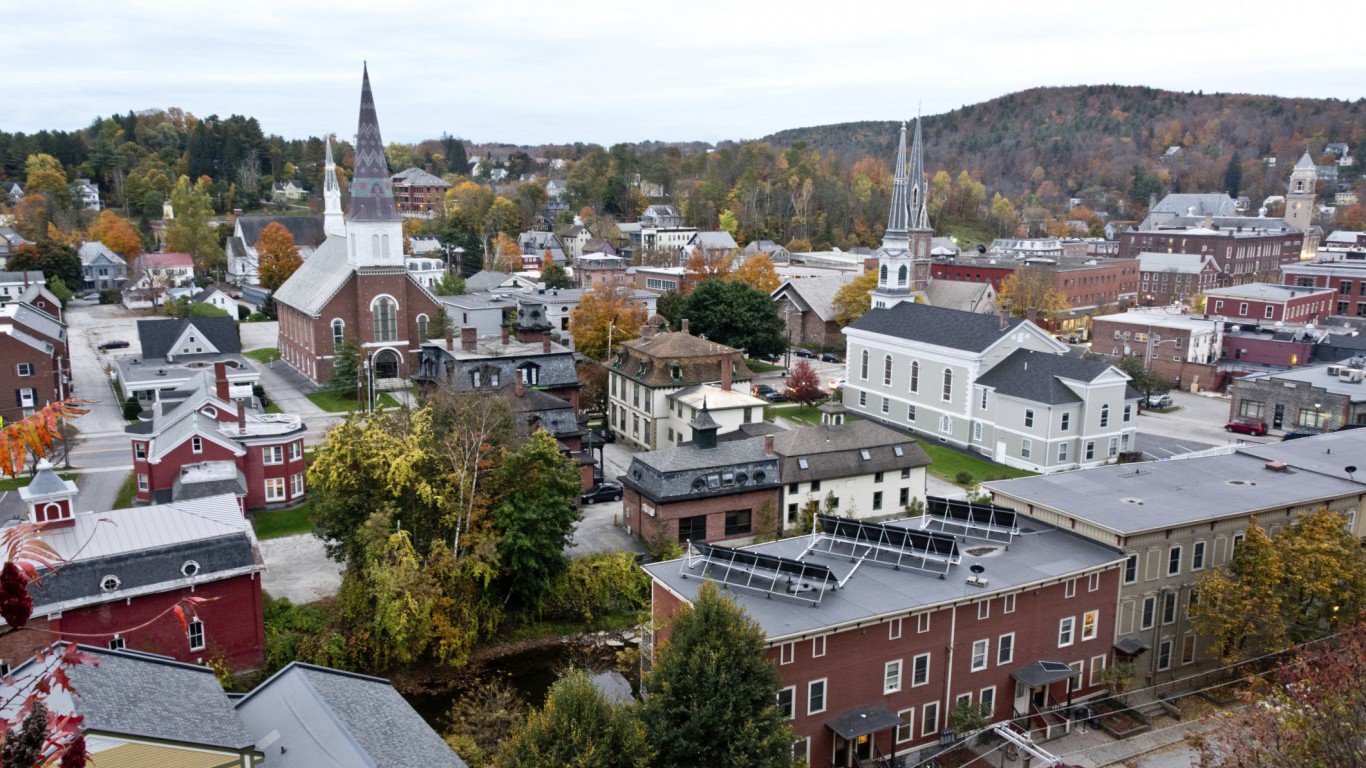
4. Vermont
> Increase in Alzheimer’s, 2017-2025: 41.7%
> Pct. of 65+ pop. with Alzheimer’s: 10.9% (14th lowest)
> Population 65+: 17.6% (4th highest)
> Pct. of 65+ pop. in good health: 78.7% (11th highest)
> Avg. retirement income: $21,537 (15th lowest)
Many of the states where the number of Alzheimer’s disease cases are expected to increase the most have relatively small populations of 65 and over residents. In Vermont, however, the elderly population comprises 17.6% of the population, the fourth largest share of any state. The projected sharp increase in Alzheimer’s in Vermont may be partially due to the large share of individuals 75 and over, who in Vermont comprise 7.2% of residents, sixth highest such share. The risk of Alzheimer’s goes up significantly with age also among the elderly.

3. Nevada
> Increase in Alzheimer’s, 2017-2025: 48.8%
> Pct. of 65+ pop. with Alzheimer’s: 10.2% (6th lowest)
> Population 65+: 14.6% (15th lowest)
> Pct. of 65+ pop. in good health: 78.2% (15th highest)
> Avg. retirement income: $28,364 (7th highest)
The Nevada Department of Health and Human Services in January proposed nine recommendations to address Alzheimer’s disease in its state. Among the recommendations was fostering dementia-friendly communities by implementing information and referral systems for those living with Alzheimer’s disease and other forms of dementia, as well as for their caregivers and their families, to enable them to connect with local case managers and support services.
As is almost always the case at the top end of this list, the projected increase in Nevada’s elderly population of 32.3% far outpaces the projected growth nationwide and largely explains the anticipated spike in Alzheimer’s cases. Medicaid costs for those with the disease are expected to surge by 70.6% by 2025, the second largest increase after only Alaska.

2. Arizona
> Increase in Alzheimer’s, 2017-2025: 53.8%
> Pct. of 65+ pop. with Alzheimer’s: 11.6% (20th highest)
> Population 65+: 16.4% (10th highest)
> Pct. of 65+ pop. in good health: 76.4% (25th lowest)
> Avg. retirement income: $24,985 (19th highest)
Alzheimer’s disease was the eighth leading cause of death in Arizona, according to statistics from the Centers for Disease Control and Prevention. It is the sixth leading cause of death in the United States. The disease claimed 2,485 lives in Arizona in 2014, and when adjusted to the population the death rate from the disease amounts to 36.9 deaths per 100,000 people — the 11th highest Alzheimer’s mortality rate of all states. Arizona’s elderly population, which already comprises one of the largest shares of the population of all states, is projected to grow by approximately 29.1% by 2025, the 10th fastest pace compared to other states.
[in-text-ad-2]

1. Alaska
> Increase in Alzheimer’s, 2017-2025: 54.9%
> Pct. of 65+ pop. with Alzheimer’s: 10.0% (5th lowest)
> Population 65+: 9.6% (the lowest)
> Pct. of 65+ pop. in good health: 74.8% (19th lowest)
> Avg. retirement income: $32,226 (the highest)
By 2025, Alaska’s elderly population will grow by approximately 35.6% from 70,900 to 110,000 people 65 and over, the fastest projected growth rate of all states. The growth largely accounts for the state’s nation-leading anticipated growth in Alzheimer’s cases.
Alaska has the lowest mortality rate from Alzheimer’s disease of any state, with 9.2 deaths per 100,000 people. The U.S. mortality rate from Alzheimer’s disease was more than triple that of Alaska’s, at 29 deaths per 100,000 people in 2014. The sharp rise in the number of Alzheimer’s cases will also drive up medical costs in Alaska. While retired state residents are relatively well off — retirees’ average annual income of $32,226 is the highest in the nation — Medicaid costs for treating Alzheimer’s disease in Alaska is forecast to climb 82.5% from 2017 to 2025, the biggest increase of any state.
Detailed Findings and Methodology:
One in 10 people 65 and older in the United States have Alzheimer’s dementia, according to the report. The symptoms include difficulties with memory, language, problem-solving, and other cognitive skills that affect a person’s ability to perform everyday activities.
Dr. Kenneth Langa of the University of Michigan, whose research focuses on the epidemiology and costs of chronic diseases in older adults, detailed in an email to 24/7 Wall St. the key factors that lead to differences in the incidence of the disease across states.
Since age is the biggest risk factor in developing Alzheimer’s, Langa noted that states with generally older populations would be expected to have more Alzheimer’s cases than states with younger populations. Also, some socioeconomic conditions such as lower levels of income and education are associated with increased Alzheimer’s incidence.
In Alaska, the percentage of the population who are 65 and older is forecast to rise to between 12% and 15% by 2020, and to between 15% and 18% by 2030, according to predictions from the University of Virginia Demographics Research Group.
“Alaska’s population forecast includes unusually steep percentage growth in the 65+ population,’’ said Jennifer Weuve, associate professor of epidemiology in Boston University’s School of Public Health, in an email.
The cost of caring for those with Alzheimer’s is huge and will increase as the number of individuals with the disease climbs. Total costs of care for those with Alzheimer’s or other dementias are estimated at $259 billion annually, and are predicted to reach $1.1 trillion by 2025, according to the Alzheimer’s Association. Medicare and Medicaid cover 67% of the cost of care.
On average, Medicare beneficiaries age 65 and older with Alzheimer’s or other dementias paid $10,315 out of pocket annually for health care and long-term care services not covered by other sources.
As the number of those afflicted with Alzheimer’s disease rises, the need for caregivers will become more urgent. More than 15 million Americans provided unpaid care for people with Alzheimer’s or other dementias in 2016, according to data from the Alzheimer’s Association.
To determine the states where Alzheimer’s is soaring, 24/7 Wall St. reviewed the projected increase in the number of Americans with Alzheimer’s between 2017-2025 in every state from the Alzheimer’s Association’s 2017 2017 Alzheimer’s Disease Facts and Figures report. The share of the population that is 65 years or older in each state came from the U.S. Census Bureau’s 2015 American Consumer Survey.
Thank you for reading! Have some feedback for us?
Contact the 24/7 Wall St. editorial team.